Culture
In Which of These Parks Can You Find Aboriginal Rock Paintings?
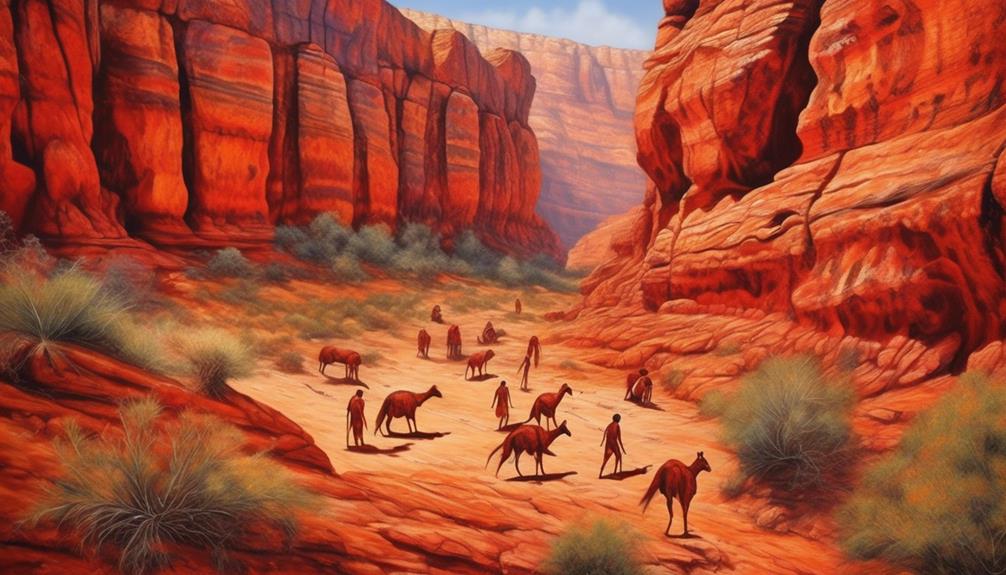
When considering the wide variety of national parks in Australia, ancient Aboriginal rock paintings may not be the first thing that comes to mind. However, these natural reserves hold a hidden treasure trove of art and cultural heritage that is both fascinating and incredibly significant.
As we explore the diverse landscapes and ecosystems of these parks, we will uncover the enigmatic connection between the Aboriginal people and their ancestral lands, and in doing so, discover where these remarkable rock paintings can be found.
Key Takeaways
- Kakadu National Park, Uluru-Kata Tjuta National Park, Flinders Ranges National Park, and Purnululu National Park are some of the parks where Aboriginal rock paintings can be found.
- Aboriginal rock paintings hold immense cultural significance as they depict Dreamtime stories, creation ancestors, and the natural environment, showcasing the rich cultural heritage of the Aboriginal people.
- The rock paintings serve as a tangible link to the past and offer insights into the beliefs, rituals, and daily lives of traditional custodians, reflecting a rich cultural tapestry.
- Preservation efforts are being made in collaboration with the local Aboriginal community, incorporating traditional knowledge and expertise, utilizing non-invasive methods for documentation and monitoring, and educating visitors about the significance of rock art in order to protect and preserve these culturally significant sites.
Kakadu National Park
Kakadu National Park, located in the Northern Territory of Australia, is home to a remarkable collection of ancient Aboriginal rock paintings. These paintings hold immense Aboriginal cultural significance and provide a window into the rich cultural heritage of the Indigenous people of Australia. The traditional art techniques used in these paintings have been passed down through generations, preserving the stories and traditions of the Aboriginal people.
The rock paintings in Kakadu National Park offer a unique insight into the spiritual and cultural beliefs of the Aboriginal people. They depict Dreamtime stories, creation ancestors, and the natural environment, showcasing the deep connection that the Aboriginal people have with the land. These paintings aren't just artworks; they're a vital link to the past, present, and future of Indigenous Australian culture.
The traditional art techniques used in these rock paintings demonstrate the skill and expertise of the Aboriginal artists. These techniques often involve using natural pigments, such as ochre, and applying them to the rock surfaces using various methods, including finger painting, stenciling, and cross-hatching. The intricate designs and detailed depictions in the rock art highlight the artistic mastery of the Aboriginal people and their deep understanding of the natural world.
Visiting Kakadu National Park offers a profound opportunity to witness and appreciate the ancient art form that holds such significant cultural importance. It allows us to honor and respect the traditions and stories of the Aboriginal people while marveling at the artistic brilliance encapsulated in these rock paintings.
Uluru-Kata Tjuta National Park
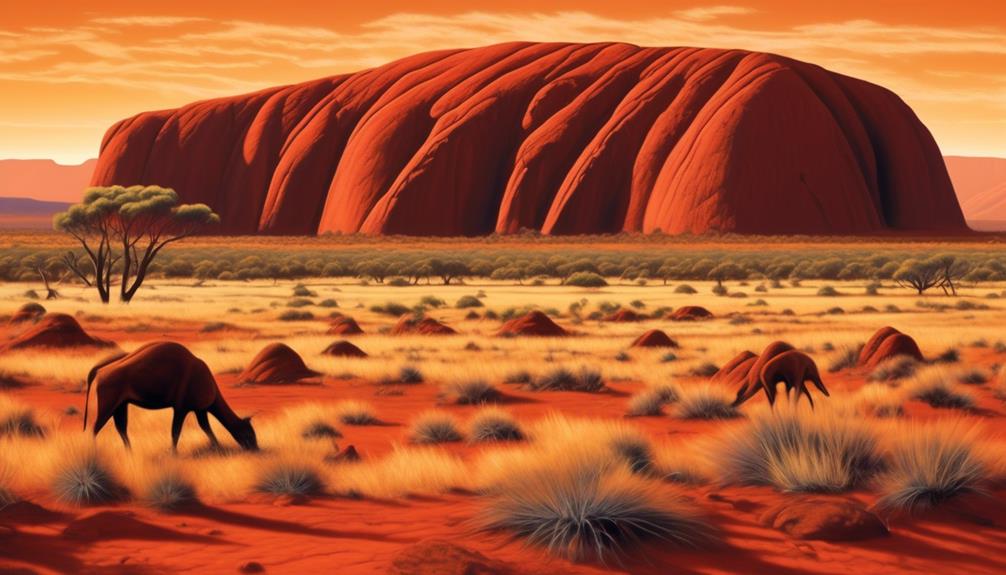
The rich cultural heritage of Indigenous Australian rock paintings continues to be showcased at Uluru-Kata Tjuta National Park, where the ancient art form provides a profound insight into the spiritual and cultural beliefs of the Aboriginal people. The park holds immense cultural significance as it's home to numerous rock art sites, some of which are believed to be over 10,000 years old. These paintings depict stories of creation ancestors, spiritual beings, and the natural environment, offering a window into the traditional knowledge and practices of the Anangu people, the traditional owners of the land.
The traditional techniques used in creating these rock paintings have been passed down through generations, using natural pigments derived from plants, ochre, and other materials. The intricate designs and vibrant colors reflect the deep connection the Aboriginal people have with the land and their profound understanding of its resources.
Preservation methods and conservation efforts at Uluru-Kata Tjuta National Park are of paramount importance to ensure the longevity of these invaluable cultural treasures. The park management, in collaboration with the Anangu traditional owners, employs various strategies such as monitoring visitor access to sensitive areas, implementing erosion control measures, and conducting regular maintenance to safeguard the rock art sites for future generations.
Visitors to the park are encouraged to respect and appreciate the significance of the rock art, and to engage with the cultural interpretation provided by the local Indigenous guides. By fostering a deeper understanding and respect for this ancient art form, we can contribute to the preservation of the cultural heritage embodied in the rock paintings at Uluru-Kata Tjuta National Park.
Flinders Ranges National Park
What fascinating cultural treasures await visitors at the Flinders Ranges National Park, and how do they connect us to the ancient history of the land?
The Flinders Ranges National Park is home to some of the most significant examples of Aboriginal art in Australia, providing a window into the cultural significance of this ancient land.
Here are four key aspects of the Aboriginal rock paintings that make this park a must-visit:
- Cultural Significance: The rock paintings in Flinders Ranges National Park aren't only beautiful works of art but also hold immense cultural significance for the Adnyamathanha people, the traditional owners of the land. These paintings depict stories of creation, important cultural practices, and the relationship between the people and the land.
- Preservation Efforts: The park authorities, in collaboration with the local Aboriginal community, have been dedicated to the preservation of these ancient artworks. Through careful conservation efforts, these rock paintings are being protected for future generations, ensuring that the rich cultural heritage they represent endures.
- Rock Painting Locations: Visitors to the park have the opportunity to see these remarkable rock paintings at several locations, including Arkaroo Rock and Yourambulla Caves. These sites not only showcase the artistic prowess of the Aboriginal people but also provide a deeper understanding of their connection to the land.
- Connection to Ancient History: The rock paintings at Flinders Ranges National Park offer a unique opportunity to connect with the ancient history of Australia, allowing visitors to appreciate the enduring legacy of the Aboriginal culture in this breathtaking landscape.
Purnululu National Park

As we shift our focus to Purnululu National Park, we're eager to explore the significance of the rock paintings and the ongoing efforts to preserve them.
The rich cultural history depicted in the rock art provides a window into the traditions and stories of the Aboriginal people who've called this land home for thousands of years.
Understanding the importance of these paintings is crucial for ensuring their protection and continued appreciation for generations to come.
Rock Painting Significance
Located within the striking landscape of Purnululu National Park, the rock paintings hold profound cultural and historical significance for the Aboriginal people. These ancient artworks are a testament to the enduring legacy of Aboriginal culture and the deep connection to the land.
The significance of the rock paintings lies in:
- Preserving Indigenous Knowledge: The art serves as a repository of traditional knowledge, depicting stories, rituals, and spiritual beliefs passed down through generations.
- Cultural Continuity: The paintings symbolize the enduring presence of Aboriginal culture and its resilience in the face of societal changes over millennia.
- Connection to Country: They represent a tangible link to the land, reflecting the intimate relationship between the Aboriginal people and their ancestral territory.
- Indigenous Culture Appreciation: By understanding and respecting these artworks, visitors can gain insight into the rich and diverse Indigenous cultures that have thrived in Australia for thousands of years.
Preservation Efforts
Efforts to preserve the culturally significant rock paintings in Purnululu National Park are an integral part of our commitment to honoring and protecting the rich heritage of the Aboriginal people. Indigenous involvement in preservation techniques is crucial to ensure the longevity of these precious artworks. We actively engage with the local Aboriginal community to incorporate their traditional knowledge and expertise in preserving and caring for these ancient paintings. Our collaborative efforts also extend to community engagement and educational programs, aiming to raise awareness and appreciation for the cultural significance of these rock paintings. Together, we work to develop sustainable preservation strategies that respect and uphold the values of the Aboriginal people. It's essential to involve and empower the community to ensure the long-term preservation of this extraordinary cultural heritage.
| Indigenous Involvement | Preservation Techniques | Community Engagement | Educational Programs |
|---|---|---|---|
| Active participation of Indigenous elders and community members | Use of non-invasive conservation methods | Encouraging local participation and awareness | Educational initiatives for visitors and schools |
Burrup Peninsula
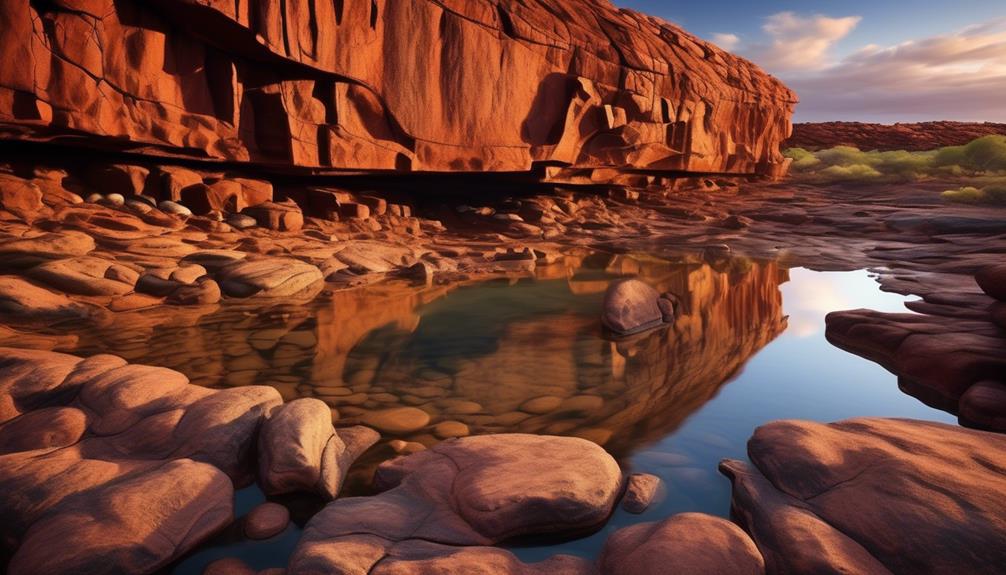
As we explore the Aboriginal rock paintings in Burrup Peninsula, it's important to recognize their cultural significance and the preservation efforts in place.
These ancient artworks provide a deep connection to the history and spirituality of the Aboriginal people, and it's crucial to respect and protect this heritage.
Cultural Significance
With deep reverence for the ancient heritage of the Burrup Peninsula, the rock paintings serve as a profound testament to the enduring cultural significance of the Aboriginal people. These paintings hold immense value, not only as a link to the past but also as a living expression of Aboriginal traditions and cultural heritage.
As custodians of this land, we acknowledge the responsibility to ensure the conservation and preservation of these invaluable treasures. The indigenous art depicted in these rock paintings reflects a deep connection to the land and a rich cultural tapestry that has withstood the test of time.
It's a privilege to witness and learn from these artworks, which continue to inspire awe and respect for the enduring legacy of the Aboriginal people.
- The rock paintings are a living expression of Aboriginal traditions and cultural heritage.
- We've a responsibility to ensure the conservation and preservation of these invaluable treasures.
- The indigenous art depicted in the rock paintings reflects a deep connection to the land.
- The paintings inspire awe and respect for the enduring legacy of the Aboriginal people.
Preservation Efforts
Amidst the rugged beauty of the Burrup Peninsula, our commitment to safeguarding the ancient rock paintings is unwavering. Indigenous involvement is integral to our conservation initiatives, as we recognize the significance of traditional knowledge in preserving these invaluable artworks. We have established a collaborative approach that combines traditional techniques with modern preservation methods. This ensures that the rock paintings are protected in a culturally sensitive manner, respecting the heritage of the indigenous communities. Our efforts also include ongoing research to develop innovative ways to mitigate environmental impact and natural deterioration. Below is a summary of our preservation efforts:
| Indigenous Involvement | Conservation Initiatives | Preservation Techniques |
|---|---|---|
| Active participation of local Indigenous communities | Implementation of protective zoning and monitoring programs | Use of non-invasive digital documentation and climate control methods |
Through these combined efforts, we aim to secure the preservation of these ancient rock paintings for future generations.
Carnarvon Gorge National Park
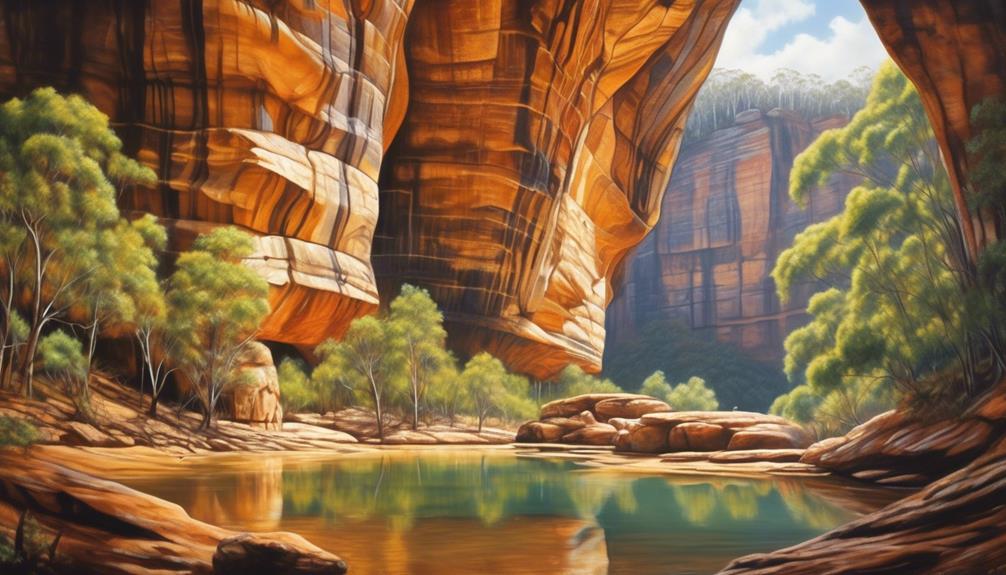
Exploring Carnarvon Gorge National Park reveals a rich tapestry of Aboriginal rock paintings that offer unique insights into the cultural heritage of the region. These ancient artworks, created by the Indigenous people who've called this land home for thousands of years, hold immense historical significance, providing a window into the traditions, beliefs, and daily lives of the original inhabitants of this area. As we wandered through the park, we were captivated by the stories depicted in the rock art, each painting a testament to the enduring connection between the Indigenous people and the land they've revered for generations.
Here are 4 fascinating aspects of the Aboriginal rock paintings at Carnarvon Gorge National Park:
- Diverse Themes: The rock paintings depict a wide range of subjects, including human figures, animals, spiritual beings, and intricate patterns, reflecting the multifaceted aspects of Indigenous life and culture.
- Cultural Preservation: These ancient artworks serve as a living record of the traditions and customs of the Aboriginal people, allowing us to gain a deeper understanding of their rich cultural heritage.
- Artistic Techniques: The skill and artistry exhibited in these rock paintings are truly remarkable, showcasing the creativity and craftsmanship of the Indigenous artists who contributed to this extraordinary legacy.
- Spiritual Significance: Many of the rock art sites are considered sacred by the local Indigenous communities, underscoring the spiritual importance of these locations and the enduring cultural practices associated with them.
Visiting Carnarvon Gorge National Park offers a profound opportunity to appreciate and honor the Indigenous art and heritage that enriches this breathtaking landscape.
Limmen National Park
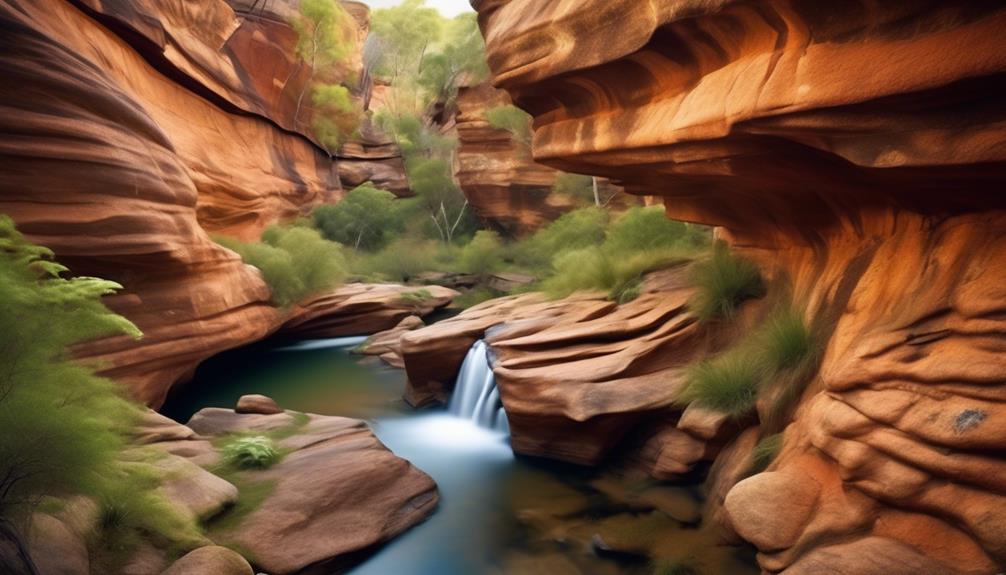
Nestled within the rugged beauty of the Northern Territory, Limmen National Park beckons with its untouched landscapes and promises of remarkable encounters with Aboriginal rock art. As visitors, we're privileged to witness the enduring legacy of the Indigenous peoples in the form of rock art that adorns the park's ancient rock formations. This significant cultural heritage is a testament to the deep connection that the Indigenous communities have with this land.
Rock art preservation is of utmost importance in Limmen National Park. The custodians of this land, the Indigenous traditional owners, have been instrumental in the preservation efforts. Their traditional knowledge and practices are crucial in ensuring that these delicate and ancient artworks are protected for future generations. The park management also plays a vital role in collaboration with the Indigenous communities to safeguard and conserve these invaluable cultural expressions.
Indigenous heritage protection is a central aspect of the management and conservation strategies in Limmen National Park. It involves not only the physical preservation of the rock art but also the promotion of understanding and respect for the stories and traditions behind the art. As visitors, we've the responsibility to engage with the rock art in a respectful and culturally sensitive manner, honoring the living culture from which it stems.
Limmen National Park stands as a testament to the enduring legacy of the Indigenous peoples and the ongoing efforts towards rock art preservation and Indigenous heritage protection. As visitors, it's our privilege to immerse ourselves in this rich tapestry of history and culture while respecting and honoring its significance.
Dampier Peninsula
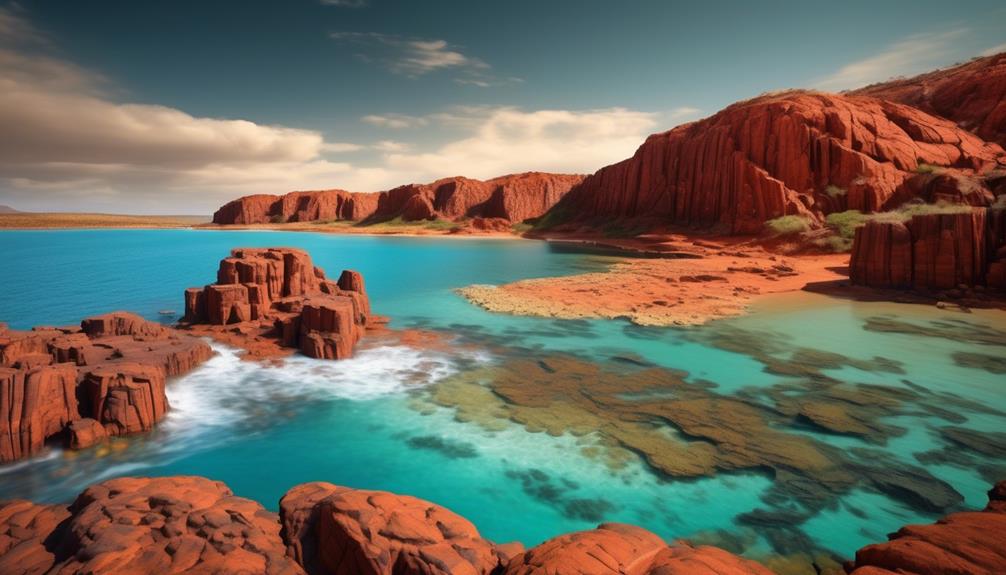
Continuing our exploration of Aboriginal rock art and cultural heritage, we now turn our attention to the captivating Dampier Peninsula in the Northern Territory. This region is a treasure trove of Indigenous culture and traditional art, offering a glimpse into the rich history and artistic traditions of the Aboriginal people.
Here are some fascinating aspects to consider when delving into the Aboriginal rock art of the Dampier Peninsula:
- Rich Cultural Significance: The Dampier Peninsula holds deep cultural significance for the local Aboriginal communities, with rock art sites serving as important repositories of traditional knowledge and spiritual beliefs.
- Diverse Artistic Styles: The rock art found on the Dampier Peninsula showcases a diverse range of artistic styles, reflecting the different cultural practices and artistic expressions of the Indigenous groups that have inhabited the region for thousands of years.
- Stories and Symbolism: Each rock painting and engraving tells a story, often depicting dreamtime narratives, ancestral beings, and important events in the history of the local Indigenous communities. These artworks are imbued with symbolic meanings that are integral to the cultural identity of the Aboriginal people.
- Preservation Efforts: Efforts are underway to preserve and protect the rock art of the Dampier Peninsula, ensuring that future generations can continue to appreciate and learn from these invaluable expressions of Indigenous heritage.
Exploring the rock art of the Dampier Peninsula provides a profound opportunity to engage with the living culture and artistic traditions of Australia's First Nations peoples.
Wollemi National Park
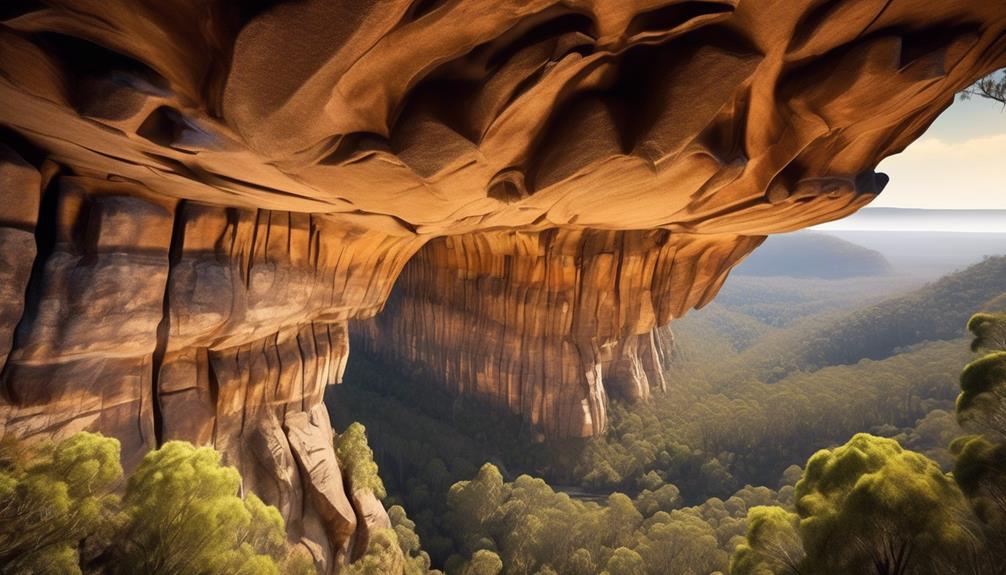
As we explore Wollemi National Park, it's essential to highlight the significant locations of ancient rock paintings, their cultural significance, and the ongoing efforts to preserve these invaluable historical treasures.
These rock paintings provide a window into the rich traditions and stories of the Aboriginal people, offering us a deeper understanding of their heritage and connection to the land.
Rock Painting Locations
Located within Wollemi National Park are several significant sites showcasing ancient Aboriginal rock paintings that offer a glimpse into the rich cultural history of the indigenous people. These rock paintings provide a window into the rock painting techniques and Aboriginal storytelling traditions.
Here are four remarkable locations within Wollemi National Park where you can find these captivating rock paintings:
- Colo Meroo: This site features a collection of rock shelters adorned with vibrant rock art, depicting various aspects of Aboriginal life and spiritual beliefs.
- Wheeny Creek: Here, you can explore rock overhangs adorned with striking paintings that narrate important stories and traditions of the local Aboriginal people.
- Newnes Plateau: This area boasts an array of rock art, including hand stencils, animal depictions, and intricate patterns, offering insight into the diverse artistic styles of Aboriginal cultures.
- Dharug National Park: Within this part of the Wollemi National Park, you can discover ancient rock art sites that showcase the enduring connection of the Dharug people to the land through their art.
Cultural Significance
The cultural significance of Wollemi National Park is deeply rooted in the ancient traditions and spiritual connections of the Aboriginal people. This is evident from the remarkable rock paintings found throughout the park, which serve as more than just artworks. They are a living record of cultural practices and historical significance.
These paintings provide a tangible link to the past, offering insights into the beliefs, rituals, and daily lives of the traditional custodians of this land. They hold immense value as a place where these practices and traditions were carried out for thousands of years, leaving an indelible mark on the landscape.
It is crucial to approach these sites with respect and reverence, recognizing their importance in preserving and understanding the rich cultural heritage of the Aboriginal people.
Preservation Efforts
Preserving the rich cultural heritage of Wollemi National Park is a vital endeavor that requires ongoing commitment and collaboration. As custodians of this land, we're dedicated to employing effective preservation techniques and fostering community involvement to protect the Aboriginal rock paintings for future generations.
Here are some of the strategies and initiatives we're implementing:
- Utilizing non-invasive methods for documentation and monitoring to minimize any impact on the rock paintings.
- Engaging local Aboriginal communities in the preservation efforts, respecting their cultural knowledge and expertise.
- Conducting regular maintenance and conservation work to safeguard the rock paintings from environmental degradation.
- Educating visitors about the significance of the rock art and encouraging responsible tourism practices to ensure its long-term preservation.
Blue Mountains National Park
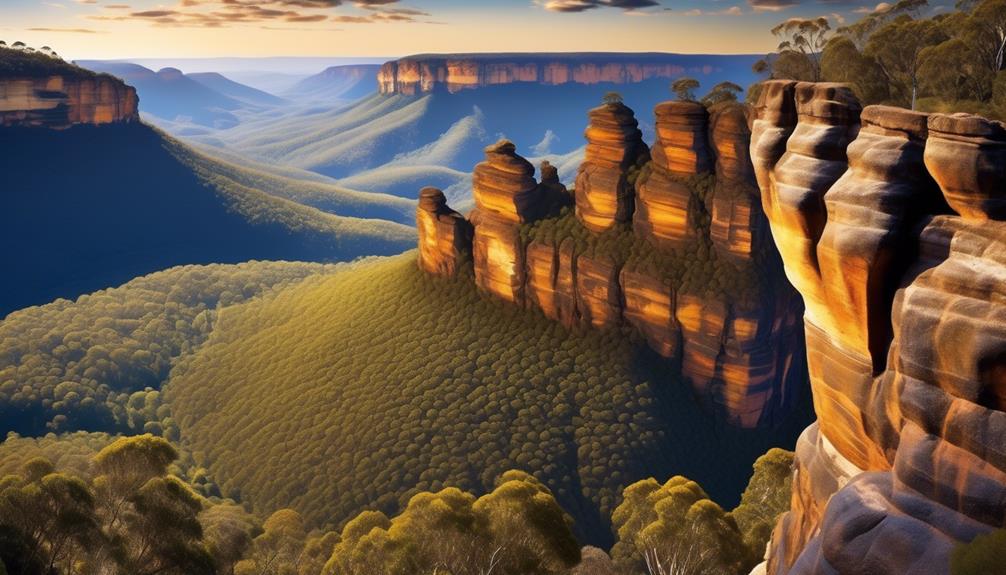
Nestled within the breathtaking Blue Mountains National Park are ancient Aboriginal rock paintings that offer a profound insight into the rich cultural heritage of the indigenous people. These remarkable artworks, estimated to be thousands of years old, are a testament to the deep connection the Aboriginal people have with this land.
The Blue Mountains hold significant spiritual and cultural importance for the local indigenous communities, and the rock paintings serve as a tangible link to their ancestors and their enduring traditions.
The presence of these ancient rock paintings underscores the importance of preserving indigenous culture within the Blue Mountains National Park. Conservation efforts are crucial to safeguarding these invaluable historical and cultural treasures for future generations. Park authorities and indigenous groups work collaboratively to ensure that these rock art sites are protected from environmental degradation, vandalism, and other threats. Through careful management and education, there's a concerted effort to raise awareness about the significance of these sites and to promote respect for indigenous heritage.
Visitors to the Blue Mountains National Park have the opportunity to engage with the rich indigenous culture and gain a deeper understanding of the spiritual and artistic traditions expressed in the rock paintings. It's a privilege to witness these ancient artworks and to appreciate the enduring legacy of the Aboriginal people, whose connection to this land spans millennia.
Ku-ring-gai Chase National Park
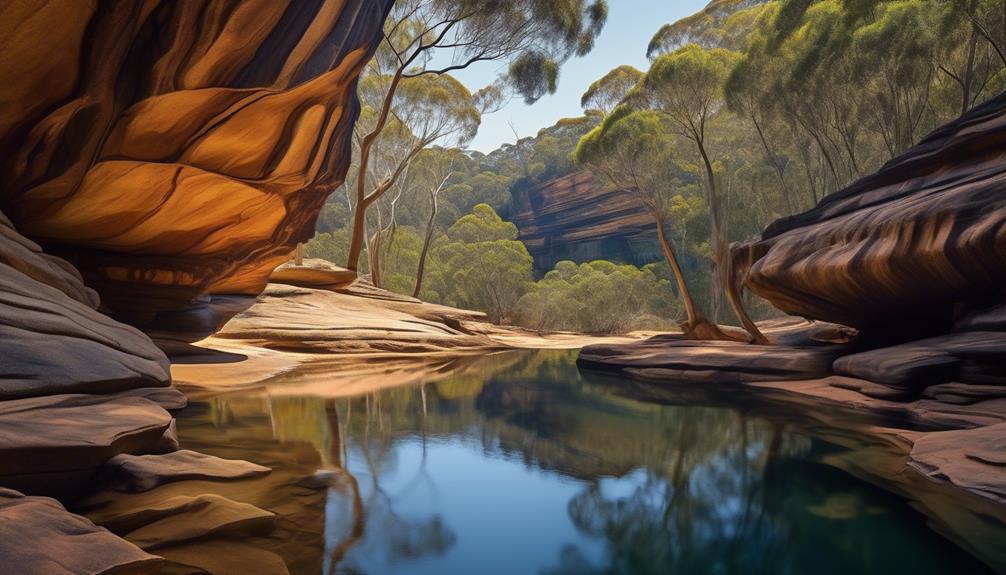
Exploring the Ku-ring-gai Chase National Park, one encounters another remarkable showcase of ancient Aboriginal rock paintings, continuing the journey of understanding and appreciating the enduring cultural legacy of the indigenous people in this region.
The park not only offers stunning natural beauty but also serves as a living testament to the rich Indigenous heritage and artistic expression of the Aboriginal people.
Here are a few captivating aspects that make the Ku-ring-gai Chase National Park a significant site for experiencing the ancient Aboriginal rock paintings:
- Diverse Rock Art Sites: The park is home to a wide variety of rock art sites, each offering a unique glimpse into the artistic expression and cultural practices of the Aboriginal people who've inhabited this land for thousands of years.
- Spiritual and Cultural Significance: The rock paintings serve as a powerful reminder of the deep spiritual and cultural connections that the Aboriginal communities have with the land, providing insights into their belief systems and way of life.
- Preservation Efforts: Efforts to preserve and protect these ancient artworks are ongoing, with initiatives aimed at safeguarding the rock paintings for future generations to appreciate and learn from.
- Educational Opportunities: Visitors have the opportunity to engage in educational programs and guided tours that provide valuable context and understanding of the significance of the rock art, fostering greater respect and appreciation for Indigenous heritage and artistic expression.
The Ku-ring-gai Chase National Park stands as a testament to the enduring legacy of the Aboriginal people, offering a profound and enriching experience for those seeking to connect with Australia's ancient cultural heritage.
Arnhem Land
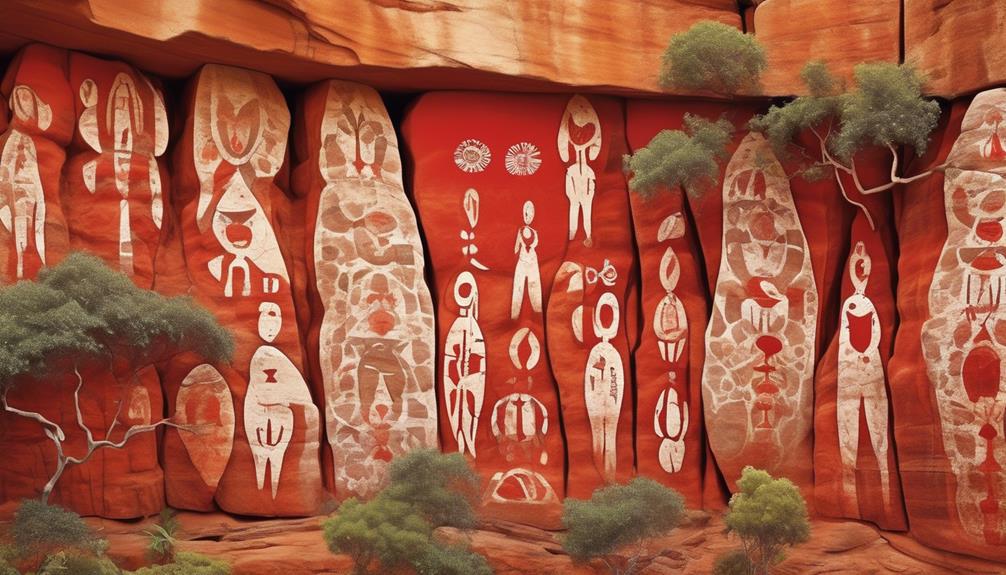
Arnhem Land provides a captivating insight into the rich cultural heritage of the Indigenous people, showcasing an extraordinary array of ancient Aboriginal rock art sites. The preservation techniques employed in Arnhem Land are crucial in safeguarding these invaluable cultural treasures.
Traditional art techniques, such as using natural pigments derived from plants and minerals, have been passed down through generations and continue to be utilized in creating and maintaining these remarkable rock paintings.
The preservation techniques in Arnhem Land are a testament to the deep respect and reverence the Indigenous communities have for their cultural heritage. Through methods like regular monitoring, documentation, and controlled visitor access to the rock art sites, the traditional custodians ensure that these ancient paintings are protected from environmental degradation and human interference.
Furthermore, the traditional art techniques employed in creating these rock paintings are awe-inspiring. The intricate designs, vibrant colors, and the meticulous application of natural pigments display the exceptional skill and artistic prowess of the Aboriginal people. These traditional art techniques not only contribute to the visual splendor of the rock art sites but also serve as a living link to the rich cultural traditions of the Indigenous communities in Arnhem Land.
Frequently Asked Questions
What Is the Significance of Aboriginal Rock Paintings in These Parks?
The significance of Aboriginal rock paintings in these parks lies in their cultural heritage and the preservation of their stories and traditions.
Conservation efforts are crucial to maintain these historical artworks. They offer invaluable insights into the rich history and traditions of the Aboriginal people, serving as a testament to their enduring presence and connection to the land.
These paintings are a vital part of Australia's cultural landscape and deserve our utmost respect and protection.
Are There Any Restrictions or Guidelines for Visitors Wanting to View the Rock Paintings?
Visitor guidelines are in place to ensure the preservation of the rock paintings. Conservation efforts are a top priority, so visitors must adhere to strict guidelines.
These include:
- Staying on designated paths
- Refraining from touching the paintings
- Not using flash photography
Additionally, it's important to respect the cultural significance of the site and follow any specific rules set by the local indigenous community.
How Have the Local Aboriginal Communities Been Involved in the Preservation of These Rock Paintings?
In preserving these rock paintings, the local Aboriginal communities have played a vital role. Their involvement in conservation projects and educational programs has been instrumental in ensuring the cultural significance of the paintings is respected.
They've also actively contributed to visitor regulations, ensuring that these sacred sites are treated with reverence. It's truly inspiring to witness their dedication to preserving and sharing this invaluable part of their heritage.
Are There Any Ongoing Research or Conservation Efforts to Protect These Rock Paintings?
We are actively involved in ongoing research and conservation efforts to protect these invaluable rock paintings.
Our team collaborates closely with local Aboriginal communities to ensure that these efforts are guided by their knowledge and expertise.
We continuously seek innovative approaches and technologies to safeguard these historical treasures for future generations.
Our commitment to this preservation work is unwavering, and we're dedicated to honoring and respecting the cultural significance of these rock paintings.
Can Visitors Participate in Any Educational Programs or Tours to Learn More About the Aboriginal Rock Paintings in These Parks?
Visitors can engage in educational programs and tours to delve into the cultural significance of the Aboriginal rock paintings. Interpretation sessions provide a deep understanding of the art's historical and spiritual context.
These experiences foster a respectful connection to the land and its traditional custodians. Through these initiatives, visitors gain a mastery of the rich indigenous heritage, creating a more inclusive and knowledgeable appreciation of the rock art.
Conclusion
After exploring these amazing parks, we can confidently say that Kakadu National Park, Uluru-Kata Tjuta National Park, and Burrup Peninsula are the places to go for incredible Aboriginal rock paintings.
These ancient artworks provide a window into the rich history and culture of Australia's indigenous peoples.
So, grab your gear and head out to these stunning parks to witness these mesmerizing anachronisms for yourself.
Happy exploring!
Mary is a passionate writer who brings creativity and a fresh perspective to our team. Her words have the power to captivate and inspire, making her an essential contributor to our content. Mary’s commitment to storytelling and dedication to promoting Indigenous culture ensures that her work touches the hearts of our readers. We’re fortunate to have her as part of our team.
Culture
Willum Warrain: Embracing Indigenous Heritage
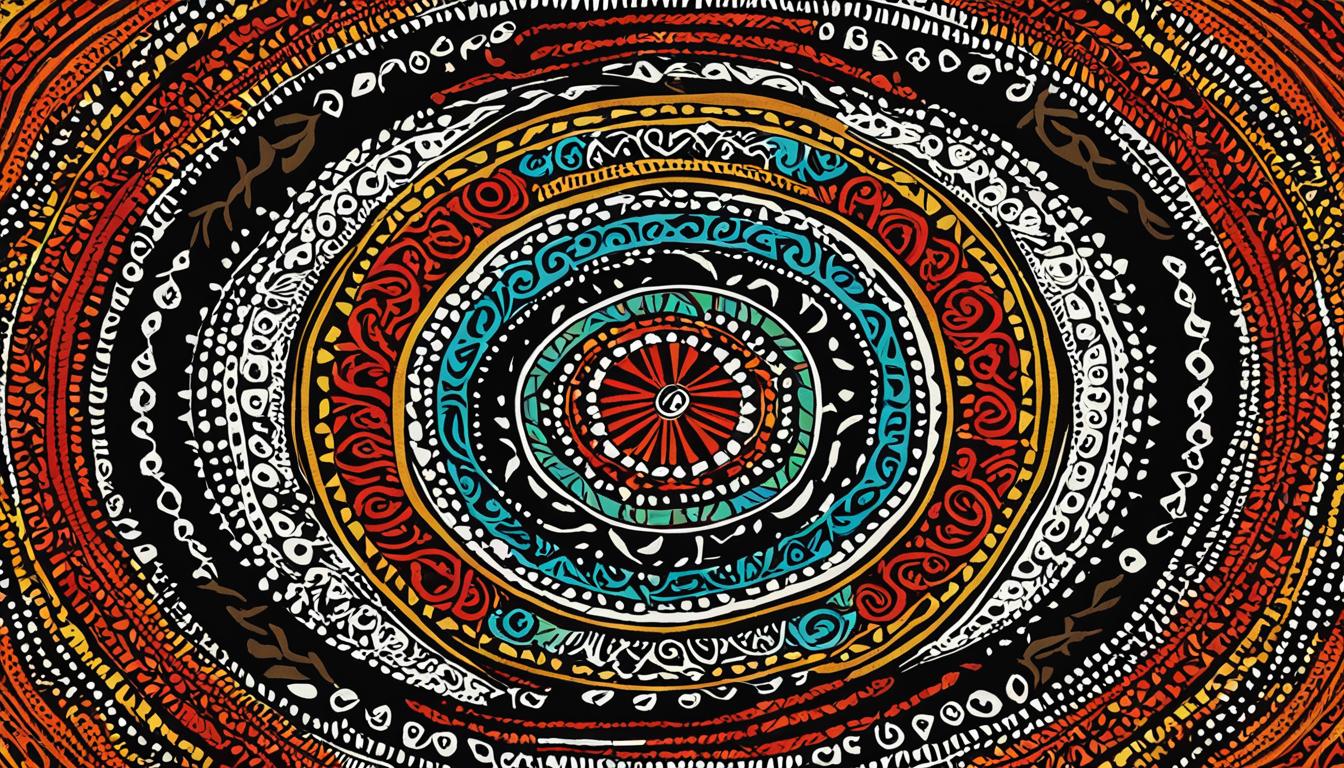
Explore the splendor of Willum Warrain, located in the center of the Mornington Peninsula, where you are invited to immerse yourself in the rich Indigenous culture of the Aboriginal and Torres Strait Islander peoples. Our deep ties to the nearby communities form the foundation of who we are, drawing inspiration from their age-old stories and traditions to create genuine Indigenous-influenced experiences and enhance our environment.
At Willum Warrain, we believe in celebrating and honoring the history, culture, and achievements of Indigenous peoples. We understand the importance of fostering respectful relationships and working in partnership with Aboriginal and Torres Strait Islander communities to create positive change.
To explore the unique beauty and cultural richness of Willum Warrain, visit our website. It showcases the diverse range of experiences and events that we offer, allowing you to connect with the Indigenous heritage of this land.
Key Takeaways:
- Willum Warrain is a place on the Mornington Peninsula that embraces and celebrates Indigenous heritage.
- We have deep cultural partnerships with local Aboriginal and Torres Strait Islander communities.
- Our website is the gateway to discovering the authentic cultural experiences we offer.
- We are committed to fostering respectful relationships and creating positive change in collaboration with Indigenous communities.
- Explore Willum Warrain to connect with the rich history, culture, and achievements of Indigenous peoples.
Connecting with the Aboriginal and Torres Strait Islander Communities
At Willum Warrain, we have established a strong connection with the Aboriginal and Torres Strait Islander communities on the Mornington Peninsula. As we celebrate and embrace Indigenous heritage, we recognize the importance of building meaningful relationships in order to honor and preserve the traditions and culture of the Bunurong, Wurundjeri Woi-wurrung, and Wadawurrung peoples who are the traditional custodians of this land.
This connection is fostered through our cultural partnerships with Registered Aboriginal Parties, such as the Bunurong Land Council Aboriginal Corporation, Wurundjeri Woi-wurrung Cultural Heritage Aboriginal Corporation, and Wadawurrung Traditional Owners Aboriginal Corporation. These organizations play a crucial role in safeguarding the cultural heritage of the region and ensuring that the voices and perspectives of the Aboriginal and Torres Strait Islander communities are valued and respected.
In addition to these Registered Aboriginal Parties, we work closely with other Aboriginal organizations active in the area. The Boon Wurrung Foundation and the Wathaurong Aboriginal Cooperative are key contributors to the preservation and promotion of Aboriginal culture and heritage on the Mornington Peninsula.
Aboriginal and Torres Strait Islander Organizations on the Mornington Peninsula
| Organization | Role |
|---|---|
| Bunurong Land Council Aboriginal Corporation | Preserves and promotes Aboriginal culture and heritage |
| Wurundjeri Woi-wurrung Cultural Heritage Aboriginal Corporation | Safeguards cultural heritage and educates the community |
| Wadawurrung Traditional Owners Aboriginal Corporation | Protects Wadawurrung heritage and supports community development |
| Boon Wurrung Foundation | Engages in cultural education and preservation activities |
| Wathaurong Aboriginal Cooperative | Provides support services to the local Aboriginal community |
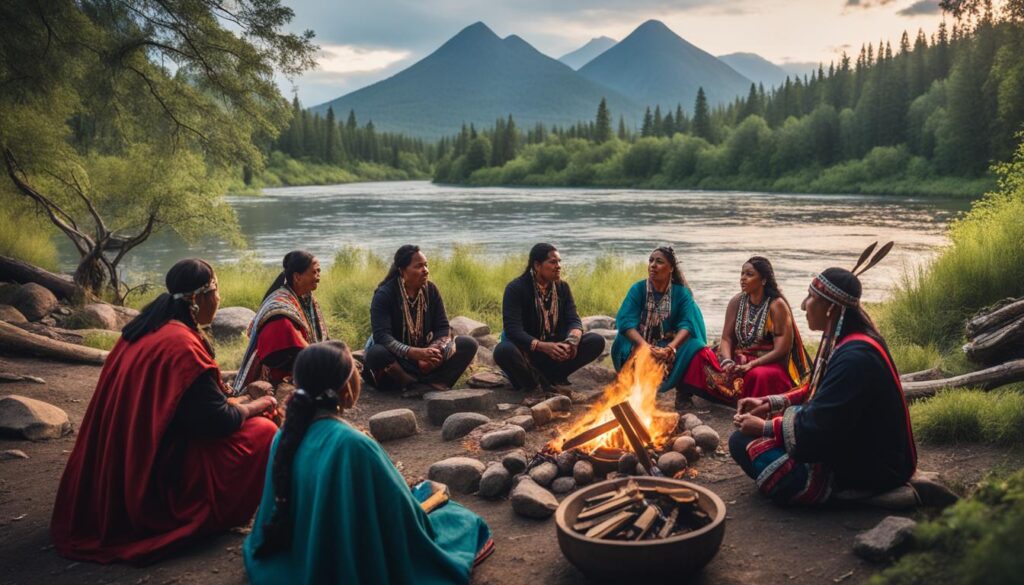
Our collaboration with Aboriginal and Torres Strait Islander communities goes beyond cultural partnerships. We actively seek their input and engage in open dialogues to ensure that their voices are heard and respected in all aspects of our operations at Willum Warrain. Through this ongoing connection, we aim to create a space where the rich heritage and traditions of Australia’s First Nations Peoples are celebrated and shared with visitors from near and far.
Protecting Aboriginal Heritage Sites
Protecting the invaluable Aboriginal heritage sites is crucial for the healing of generations, preserving the rich history, culture, and deep connection to Country. To ensure the safeguarding and documentation of these sites, the Victorian Aboriginal Heritage Register plays a pivotal role. Managed by Aboriginal Victoria, this comprehensive register contains essential information about known Aboriginal cultural heritage places and objects throughout Victoria.
Within the region, there are approximately 9,200 identified cultural heritage places, representing a diverse range of significant sites. These include middens, gathering places, burial sites, scar trees, and much more, each holding tremendous cultural value and ancient stories waiting to be shared. Unfortunately, due to rapid urban development, numerous sites have been lost or destroyed, making it increasingly critical to implement better systems for the identification and protection of cultural heritage.
By effectively managing the Victorian Aboriginal Heritage Register and partnering with local communities, organizations, and stakeholders, we can ensure the preservation and recognition of Aboriginal heritage sites for present and future generations. Together, we can honor the rich cultural tapestry woven into the fabric of our land, promoting a deeper understanding and appreciation of Australia’s First Nations Peoples.
The Significance of Country to Wurundjeri Woi-wurrung People
Country holds immense significance for the Wurundjeri Woi-wurrung people, as it represents a continuous and interconnected landscape that encompasses both tangible and intangible values. Place boundaries, as seen by the Wurundjeri Woi-wurrung, are not solely defined by property boundaries but are based on emotion, knowledge, stories, and intangible value. Country includes natural formations like rivers, creeks, and mountains, as well as cultural sites such as stone quarries, ochre mines, and earth rings.
| Country Significance | Examples |
|---|---|
| Natural Formations |
|
| Cultural Sites |
|
The Waterways of the West area, which includes the Maribyrnong River and the Werribee River, has been managed by the Wurundjeri Woi-wurrung Traditional Owners for over a thousand generations.
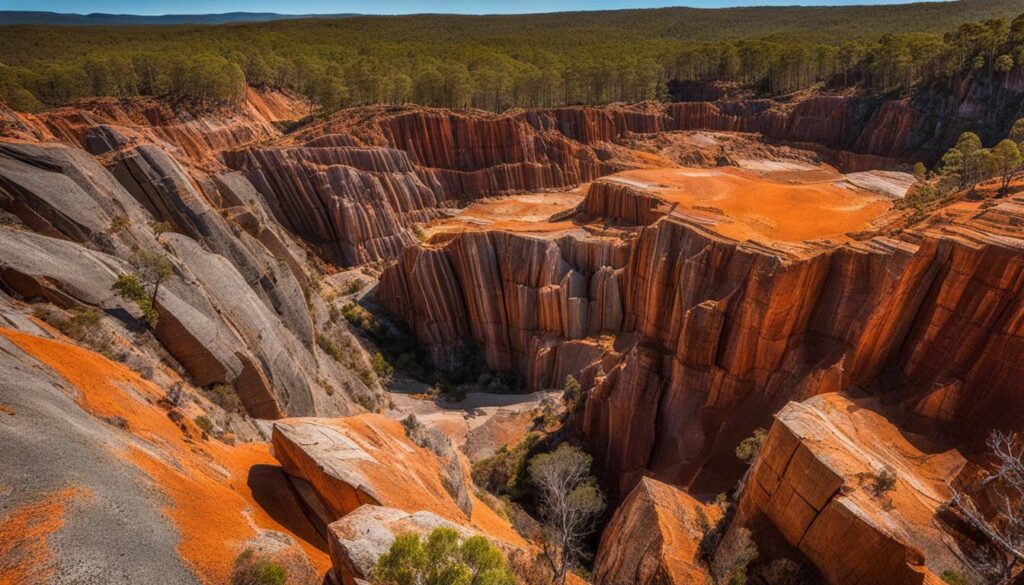
The History of Coranderrk
The story of Coranderrk, an Aboriginal reserve established in 1863, is a testament to the resilience and enduring spirit of the Wurundjeri Woi-wurrung people. Located in south-central Victoria, Coranderrk has a complex history that reflects the impact of colonial policies and external pressures on Aboriginal communities.
In its early years, Coranderrk thrived as a productive and profitable reserve under the control and management of Aboriginal people. However, over time, the reserve faced significant challenges due to the encroachment of settlers and developers and the implementation of colonial policies that diminished Aboriginal control.
Portions of the reserve were carved off and leased, stripping the Aboriginal community of their land and livelihoods. Furthermore, an illegal road was constructed, severing the connection between different parts of the reserve and disrupting the community’s way of life.
“The history of Coranderrk encompasses both triumph and tragedy, highlighting the ongoing struggle of Aboriginal peoples to maintain their cultural identity, connection to land, and self-determination.” – Wurundjeri Woi-wurrung Elder
The resilience of the Coranderrk community was tested, leading to the official closure of the reserve as an Aboriginal station in 1924. However, the story does not end there. In 1998, with the assistance of the Indigenous Land Corporation, the descendants of the Coranderrk community were able to purchase a small portion of the land that was taken from their ancestors. This symbolic act of reclaiming their ancestral homeland marks a significant step towards healing and reconciliation.
The history of Coranderrk serves as a powerful reminder of the importance of recognizing and honoring the rights and aspirations of Aboriginal communities. It is a story of resilience, determination, and the ongoing struggle for justice and self-determination.
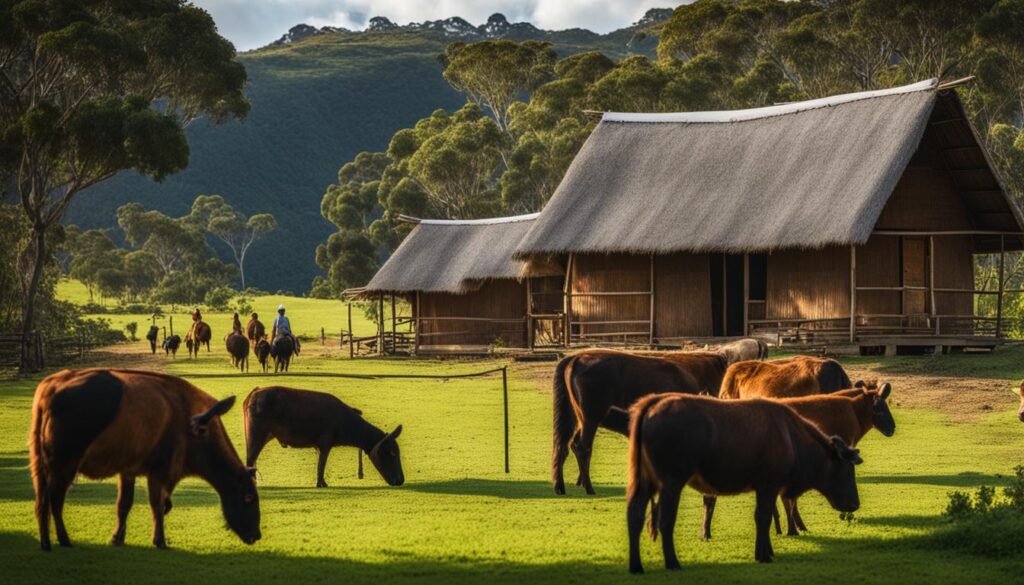
| Year | Milestone |
|---|---|
| 1863 | Establishment of Coranderrk as an Aboriginal reserve |
| 1924 | Official closure of Coranderrk as an Aboriginal station |
| 1998 | Descendants of Coranderrk community repurchase a small portion of the land |
Garambi Baan Aquaculture Area at Warrandyte
The Garambi Baan Aquaculture Area in Warrandyte holds immense cultural significance for the Wurundjeri Woi-wurrung people. This area is home to a unique rock formation spanning the Birrarung, or Yarra River, which played a crucial role in eel trapping during the eel migration period. The Wurundjeri Woi-wurrung enhanced these rock formations with strategically placed stones, creating channels that directed the eels into traps or allowed them to be caught by hand. Eel trapping was not only a practical means of sustenance but also an important cultural practice, reflecting the deep connection between the Wurundjeri Woi-wurrung and their ancestral lands.
In addition to eel trapping, the Garambi Baan Aquaculture Area also features a freshwater mussel farm. Freshwater mussels were a staple food source for the Aboriginal people, and they were collected in large quantities from the Birrarung. The mussels were then stored in pits, where they could remain fresh for up to two years. This sustainable method of farming and storing mussels ensured a stable supply of food for the Wurundjeri Woi-wurrung, showcasing their ingenuity and deep understanding of the land.
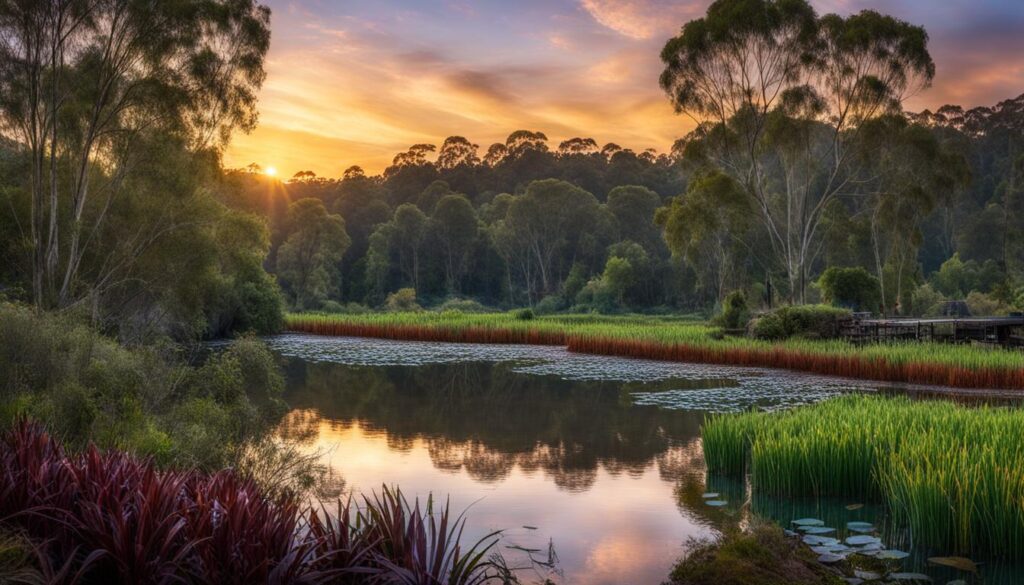
“The Garambi Baan Aquaculture Area is a testament to the Wurundjeri Woi-wurrung people’s rich cultural heritage and their profound relationship with the Birrarung. It is a place where tradition, resourcefulness, and sustainable practices converge, reminding us of the inherent wisdom and resilience of Indigenous communities.” – Wurundjeri Woi-wurrung Elder
The Sunbury Rings Complex
The Sunbury Rings Complex, owned and managed by the Wurundjeri Woi-wurrung people, is a remarkable testament to the rich cultural heritage of the area. Within this complex, we find three of the only five known earth rings in Victoria. These ancient earth rings, estimated to be approximately 1,000 years old, were created through the deliberate scraping back of earth and grass from the center of each circle, revealing a cultural significance that extends far beyond their physical appearance.
“The Sunbury Rings Complex stands as a reminder of the deep ancestral connections and ceremonial practices of the Wurundjeri Woi-wurrung people. These earth rings serve as spiritual spaces where our ancestors performed important rituals and celebrated our culture. They are a foundational part of our heritage, connecting us with our past while shaping our future.”
In recognition of their cultural significance, the Sunbury Rings Complex has been included on the Register of the National Estate, highlighting their importance as local ceremonial areas. These sacred sites provide a window into the traditions and beliefs of the Wurundjeri Woi-wurrung people and offer a unique opportunity for visitors to learn about and engage with the living culture of this ancient community.
Furthermore, the Sunbury Rings Complex is not the only cultural treasure within this vast property. It also includes an ochre mine and a silcrete quarry, both of which played vital roles in the cultural and practical aspects of Wurundjeri Woi-wurrung life. These sites offer a glimpse into the resourcefulness and ingenuity of generations past, showcasing their deep connection with the land and the materials it provided.
The Sunbury Rings Complex
| Site | Estimated Age | Significance |
|---|---|---|
| Earth Rings | Approximately 1,000 years old | Local ceremonial areas, included on the Register of the National Estate |
| Ochre Mine | Dependent on specific location within the complex | Served as a source of ochre for artistic and ceremonial purposes |
| Silcrete Quarry | Dependent on specific location within the complex | Provided a valuable material for toolmaking and other practical uses |
The Sunbury Rings Complex invites us to explore the enduring legacy of the Wurundjeri Woi-wurrung people. It is a space where ancient traditions, intricate knowledge, and profound spiritual connections converge, offering a profound understanding of the cultural significance and deep roots of the Indigenous communities in this region.
Philanthropy’s Role in Indigenous Relationships
At Willum Warrain, we believe that philanthropy plays a vital role in creating a brighter future for Aboriginal peoples. By engaging in respectful and meaningful relationships with Aboriginal communities, we can foster positive change and empower Indigenous voices.
The Fellowship for Indigenous Leadership (FIL), in collaboration with Philanthropy Australia, is dedicated to bridging the gap between philanthropy and Aboriginal and Torres Strait Islander communities. Together, we aim to cultivate effective and lasting relationships by providing tools, insights, and steps forward for funders and grantmakers.
Right Way, Wrong Way, Which Way? Events
One of the initiatives led by FIL and its partners is the Right Way, Wrong Way, Which Way? events. These gatherings bring together funders, grantmakers, and Aboriginal groups and peoples to facilitate dialogue, share knowledge, and forge meaningful connections.
“The Right Way, Wrong Way, Which Way? events provide a platform for open and honest conversations. They create a space where Aboriginal leaders can share their insights, experiences, and concerns, helping funders and grantmakers understand how to best support Aboriginal communities.” – John Smith, CEO of Philanthropy Australia
Through these events, we aim to provide funders with the tools, resources, and understanding needed to engage respectfully with Aboriginal groups and peoples. Together, we can build partnerships that are rooted in mutual respect and collaboration, ultimately contributing to positive and sustainable outcomes.
The Importance of Respectful Relationships
Respectful relationships are the foundation of effective philanthropy in Aboriginal communities. It is crucial for funders and grantmakers to approach Aboriginal leaders, communities, and organizations with respect, intentionality, and a willingness to listen and learn.
“Respecting Aboriginal culture and knowledge is key to building strong relationships. It requires recognizing the unique wisdom and knowledge that Aboriginal communities hold and acknowledging their agency in shaping their own futures.” – Jane Brown, Executive Director of the Fellowship for Indigenous Leadership
By centering respect in our partnerships, we can foster trust, understanding, and shared goals. Respectful relationships create space for collaboration, knowledge exchange, and co-design, enabling us to work together towards positive and impactful change.
In our next section, we will explore the importance of building respectful relationships with Aboriginal communities and the steps we can take to engage meaningfully and create sustainable partnerships.
Building Respectful Relationships with Aboriginal Communities
Building respectful relationships with Aboriginal communities is a nuanced endeavor that requires specialist knowledge and understanding. At the heart of this process is the need for mutual respect, engagement, and effective partnerships that honor the unique cultures and perspectives of Australia’s First Nations Peoples.
The Right Way, Wrong Way, Which Way? events provide a platform for open dialogue between Aboriginal leaders and grantmakers, facilitating meaningful discussions about good practices and challenges in philanthropy. Through these events, we aim to foster a deeper understanding and appreciation of the diverse needs and aspirations of Aboriginal communities.
Our emphasis is on forming long-term investments and mutually supportive partnerships. By establishing relationships built on trust, authenticity, and shared goals, we can work collaboratively to address social inequalities and create positive change.
“To build respectful relationships, we must approach Aboriginal leaders, communities, and organizations with respect, intentionality, and a genuine willingness to listen and learn. It is through this approach that effective partnerships can be forged, resulting in meaningful and lasting impact.” – Aboriginal leader, Right Way, Wrong Way, Which Way? event
Respecting the knowledge and experience of Aboriginal communities is integral to the success of any philanthropic endeavor. This involves recognizing and valuing the rich cultural heritage, wisdom, and leadership that Aboriginal communities bring to the table.
By engaging in respectful relationships and partnering with Aboriginal communities, we can collectively address the complex challenges faced by Australia’s First Nations Peoples and work towards a more inclusive and equitable society.
Together, let’s build a future where respectful relationships, engagement, and effective partnerships are the cornerstone of our efforts to support and uplift Aboriginal communities.
Key Learnings from Right Way, Wrong Way, Which Way?
During the enlightening Right Way, Wrong Way, Which Way? events, we gained valuable insights and learnings on how to engage with Aboriginal communities in a respectful and effective manner through philanthropy. This comprehensive document encapsulates the wisdom and experience shared by contributors, focusing on good practices, barriers, limitations, and opportunities when building meaningful funding relationships. Our aim is to equip individuals within the philanthropy sector with the knowledge and understanding to engage more effectively with Aboriginal-led community groups while respecting the principles and lived experiences of Australia’s First Nations Peoples.
Key Learnings
- Recognize and honor the unique wisdom and knowledge held by Aboriginal communities.
- Approach funding relationships with respect, intentionality, and a willingness to listen and learn.
- Build long-term investments and forge mutually supportive partnerships.
- Be mindful of the cultural, historical, and political contexts when engaging with Aboriginal communities.
- Understand and navigate the complexities and diversity within Aboriginal Australia.
“We must strive to create genuine, respectful, and collaborative partnerships that empower Aboriginal communities and support their self-determination.” – Aboriginal leader
Barriers and Limitations
- Limited understanding and awareness of Aboriginal culture and history among grantmakers.
- Power imbalances and historical mistrust that can hinder effective collaboration.
- Insufficient funding for Aboriginal-led initiatives and capacity-building efforts.
- Lack of access to networks, resources, and opportunities for Aboriginal communities.
- Complex and evolving policy frameworks that shape funding relationships.
Opportunities for Growth
- Invest in building trust and fostering authentic relationships with Aboriginal leaders and communities.
- Prioritize funding that supports Indigenous self-determination and community-led initiatives.
- Engage in ongoing learning and cultural competency training to foster understanding and awareness.
- Support initiatives that address systemic barriers and promote structural change.
- Collaborate with other stakeholders, including Indigenous organizations and advocacy groups, to amplify impact.
| Key Learnings | Barriers and Limitations | Opportunities for Growth |
|---|---|---|
| Recognize and honor Aboriginal wisdom and knowledge | Limited understanding of Aboriginal culture | Invest in building trust and authentic relationships |
| Approach funding relationships with respect | Power imbalances and historical mistrust | Prioritize funding for self-determination |
| Build long-term investments and partnerships | Insufficient funding for Aboriginal initiatives | Engage in ongoing learning and cultural competency |
| Mindful of cultural, historical, and political contexts | Lack of access to networks and resources | Support initiatives for systemic change |
| Understand the complexities within Aboriginal Australia | Complex policy frameworks | Collaborate with Indigenous organizations |
The Long-Term Vision for Aboriginal Philanthropy
A long-term vision is crucial for the success of Aboriginal philanthropy and to achieve lasting impact. We understand that true change cannot be achieved through quick fixes alone. It requires a deep recognition of the entrenched structural violence and inequity faced by Aboriginal communities.
At [Company Name], we believe in the power of long-term investment in Aboriginal programs and initiatives. Meaningful change takes time, and we are committed to supporting communities on their journey to a healthier and more sustainable future.
Our approach involves investing in building strong relationships and working in collaboration with Aboriginal communities. We recognize and value the unique wisdom and knowledge they hold, and we aim to foster an environment of trust, respect, and partnership.
Through our philanthropic efforts, we aspire to contribute to structural change by addressing the underlying issues that perpetuate inequity. By supporting Aboriginal-led initiatives and promoting self-determination, we aim to create a society that values and respects the diverse cultures and histories of Australia’s First Nations Peoples.
Illustration representing the long-term vision for Aboriginal philanthropy.
Stakeholders Involved in the Conversation
The conversation on respectful relationships with Aboriginal communities involved various stakeholders who came together to foster understanding, dialogue, and learning. This collaborative effort was driven by the Fellowship for Indigenous Leadership, Philanthropy Australia, Woor-Dungin, and Pro Bono Australia. By leveraging their collective expertise and resources, these organizations created opportunities such as presentations, webinars, and keynotes.
Through these initiatives, Aboriginal leaders, grantmakers, and social investors from Australia and New Zealand were able to come together, exchange ideas, and deepen their understanding of the principles and experiences of Australia’s First Nations Peoples. The conversations facilitated by these stakeholders aimed to build meaningful and respectful relationships, ensuring that philanthropy aligns with the needs and aspirations of Aboriginal communities.
Conclusion
At Willum Warrain, we are dedicated to embracing and celebrating the rich Indigenous heritage of the Mornington Peninsula. Our strong connections with the local Aboriginal and Torres Strait Islander communities have allowed us to create authentic experiences that highlight their traditions and practices. By preserving cultural heritage sites and fostering respectful relationships through philanthropy, we have established a strong online presence and visibility for Willum Warrain.
However, we understand the importance of digital marketing in amplifying our message and inviting more people to engage with the cultural richness we offer. Through strategic digital marketing efforts, we can reach a wider audience and encourage them to explore and connect with the unique experiences and stories that Willum Warrain has to offer.
Join us in embracing the Indigenous heritage of the Mornington Peninsula and discover the beauty and significance of Willum Warrain. Together, we can celebrate the diversity and richness of Australian culture while fostering understanding, respect, and recognition for the traditional owners of this land.
FAQ
What is Willum Warrain?
Willum Warrain is a place on the Mornington Peninsula that embraces and celebrates the Indigenous heritage of the Aboriginal and Torres Strait Islander peoples.
How is Peninsula Hot Springs connected to Willum Warrain?
Peninsula Hot Springs has deep cultural partnerships with Willum Warrain and Living Culture, drawing inspiration from their traditional stories and practices to shape the landscape and create Indigenous-inspired experiences.
What is the significance of NAIDOC Week?
NAIDOC Week is an opportunity to acknowledge and honor the history, culture, and achievements of Indigenous peoples, not just in Indigenous communities but by Australians from all walks of life. It takes place from 4-11 July every year.
Which Indigenous communities are connected to Willum Warrain?
Willum Warrain has a strong connection with the Bunurong, Wurundjeri Woi-wurrung, and Wadawurrung peoples – the traditional custodians of the Mornington Peninsula.
How many cultural heritage places are identified in the region?
There are approximately 9,200 cultural heritage places identified in the region, including middens, gathering places, burial sites, and scar trees.
What is the Victorian Aboriginal Heritage Register?
The Victorian Aboriginal Heritage Register holds information about known Aboriginal cultural heritage places and objects within Victoria. It is managed by Aboriginal Victoria.
What is the importance of Country to the Wurundjeri Woi-wurrung people?
Country holds immense significance for the Wurundjeri Woi-wurrung people, as it represents a continuous and interconnected landscape that encompasses both tangible and intangible values.
How old is the Mount William Stone Hatchet Quarry?
The Mount William Stone Hatchet Quarry is estimated to be approximately 1,000 years old and is recognized as a cultural heritage site.
What is the history of Coranderrk?
Coranderrk was established in 1863 as a reserve for Aboriginal people in south-central Victoria. However, Aboriginal control and management diminished over time due to colonial policies and external pressures, leading to its official closure in 1924.
What is the significance of Garambi Baan aquaculture area?
The Garambi Baan aquaculture area in Warrandyte holds cultural significance for the Wurundjeri Woi-wurrung people. It was used for eel trapping during the eel migration period and also included a freshwater mussel farm, a staple food source for Aboriginal people.
What is the significance of the Sunbury Rings Complex?
The Sunbury Rings Complex, owned and managed by the Wurundjeri Woi-wurrung people, contains three of only five known earth rings in Victoria. These rings are recognized as important local ceremonial areas.
What is the role of philanthropy in building respectful relationships with Aboriginal communities?
Philanthropy plays a vital role in creating respectful and meaningful relationships with Aboriginal communities by engaging in philanthropic initiatives and supporting Indigenous-led programs and organizations.
How can philanthropy build respectful relationships with Aboriginal communities?
Building respectful relationships with Aboriginal communities requires specialist knowledge and understanding. It is essential for funders and grantmakers to approach Aboriginal leaders, communities, and organizations with respect, intentionality, and a willingness to listen and learn.
What are the key learnings from the Right Way, Wrong Way, Which Way? events?
The Right Way, Wrong Way, Which Way? events provided key insights and learnings on effective philanthropic engagement with Aboriginal communities, focusing on good practices, barriers, limitations, and opportunities in building respectful funding relationships.
What is the long-term vision for Aboriginal philanthropy?
The long-term vision for Aboriginal philanthropy goes beyond quick fixes and acknowledges the deep-rooted structural violence and inequity faced by Aboriginal communities. It emphasizes the importance of investing in relationships, collaboration, and acknowledging the unique wisdom and knowledge of Australia’s First Nations Peoples.
Who are the stakeholders involved in the conversation on respectful relationships with Aboriginal communities?
The stakeholders involved in the conversation include the Fellowship for Indigenous Leadership, Philanthropy Australia, Woor-Dungin, and Pro Bono Australia, who collaborated to create opportunities for dialogue and learning.
Source Links
- https://www.peninsulahotsprings.com/journal/naidoc-week-2021
- https://portphillipwesternport.rcs.vic.gov.au/themes/traditional-owners/
- https://indigenousfellowship.net.au/wp-content/uploads/2021/01/Right-Way-Wrong-Way-Which-Way-Respectful-Relationships-FINAL-2018.pdf
Mary is a passionate writer who brings creativity and a fresh perspective to our team. Her words have the power to captivate and inspire, making her an essential contributor to our content. Mary’s commitment to storytelling and dedication to promoting Indigenous culture ensures that her work touches the hearts of our readers. We’re fortunate to have her as part of our team.
Culture
Understanding What’s the Aboriginal Flag
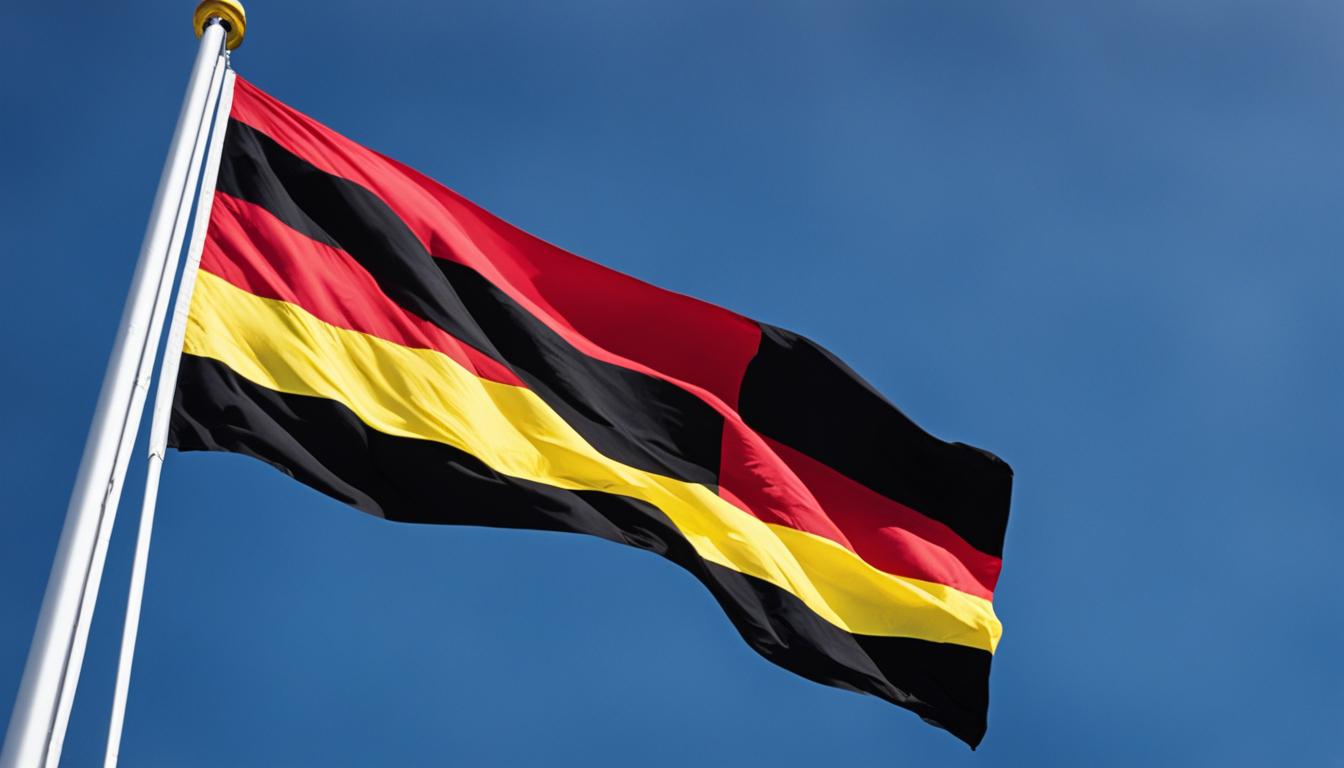
Welcome to our in-depth guide focused on the Aboriginal flag, a prominent symbol representing the heritage, identity, and ongoing struggles of Indigenous Australians. Through this thorough examination, we will explore the meaning, historical background, importance, and symbolism of this iconic flag, which holds deep cultural and political significance in Australia.
Key Takeaways:
- The Aboriginal flag was designed by Harold Thomas, a Luritja man from central Australia, in 1970.
- The flag consists of a horizontal rectangle divided into equal halves of black (representing Aboriginal people) and red (representing the earth and spiritual connection to the land).
- In the center of the flag, there is a yellow circle symbolizing the sun.
- The Aboriginal flag was first raised on July 9, 1971, and in 1995, it was recognized by the Australian Government as an official ‘Flag of Australia’.
- Its design and colors hold deep symbolism for Indigenous Australians, reflecting their identity, heritage, and spirituality.
The Design and Symbolism of the Aboriginal Flag
The design of the Aboriginal flag is a beautiful representation of Indigenous culture and heritage.
Harold Thomas, a Luritja man from central Australia, designed the flag in 1970. Its simplicity speaks volumes and has made it an iconic symbol of Aboriginal pride.
The flag’s design consists of three significant elements:
- Black: This color represents Aboriginal people, their history, and their ongoing struggles. It serves as a powerful reminder of the strength and resilience of Indigenous Australians.
- Red: Symbolizing the earth and spiritual connection to the land, the red in the flag pays homage to the deep-rooted relationship Indigenous Australians have with their ancestral lands. It reflects their profound spiritual connection and custodianship of the land.
- Yellow: The yellow circle in the center of the flag represents the sun, a vital source of life and energy. It symbolizes the ongoing presence and significance of Indigenous cultures throughout Australia.
Together, these colors convey the story of Indigenous Australians, their identity, heritage, and spirituality. The design of the Aboriginal flag is a visual testament to the rich cultural tapestry and connection to the land that Indigenous communities hold dear.
The flag’s distinct design has been widely embraced and recognized, representing Aboriginal Australia across various mediums and platforms.
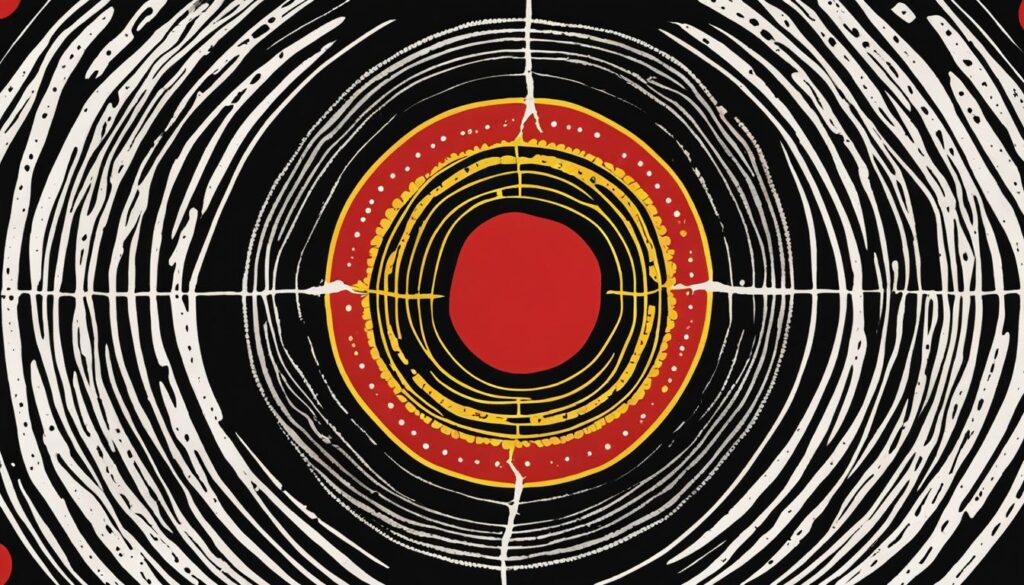
The simplicity and deep symbolism of the Aboriginal flag have made it a potent symbol of Aboriginal pride, unity, and resilience. It serves as a visual representation of the ongoing struggles, achievements, and culture of Indigenous Australians.
The History of the Aboriginal Flag
The Aboriginal flag has a rich history that encompasses the struggles, resilience, and aspirations of Indigenous Australians. It was first flown on July 9, 1971, during a land rights rally in Adelaide, South Australia, as part of the National Aborigines Day celebrations. This historic moment marked the flag’s emergence as a powerful symbol of Indigenous Australia’s fight for rights and recognition.
Designed by Harold Thomas, a Luritja man from central Australia, the Aboriginal flag embodies the deep cultural and political significance of Indigenous identity. The flag’s design features a horizontal rectangle divided equally into halves of black and red, with a vibrant yellow circle in the center.
The black represents Aboriginal people, symbolizing their resilience, strength, and pride. The red embodies the connection to the land, expressing the spiritual and cultural significance of the earth. The yellow circle represents the sun, signifying life, energy, and the ongoing presence of Indigenous cultures.
Following its inception, the Aboriginal flag quickly gained recognition and acceptance among Indigenous Australians and beyond. It became a potent symbol of their struggle for rights, self-determination, and the acknowledgment of their unique place within the Australian nation.
In 1995, the Australian Government officially recognized the Aboriginal flag as a ‘Flag of Australia’ under the Flags Act 1953, solidifying its cultural and political significance. This recognition elevated the status of the Aboriginal flag as an emblem of Indigenous pride, heritage, and resilience.
| Year | Significance |
|---|---|
| 1971 | The Aboriginal flag is first flown at a land rights rally in Adelaide, South Australia, on July 9. |
| 1995 | The Australian Government officially recognizes the Aboriginal flag as a ‘Flag of Australia.’ |
The history of the Aboriginal flag is a testament to the strength, resilience, and cultural significance of Indigenous Australians. It stands as an enduring symbol of unity, pride, and the ongoing pursuit of recognition and rights for the Indigenous communities across the nation.
Legal and Copyright Status of the Aboriginal Flag
In January 2022, the Commonwealth of Australia acquired the copyright of the Aboriginal Flag, with Carroll & Richardson-Flagworld Pty Ltd being the exclusive licensed manufacturer of the flag. The Commonwealth allows the design to be freely reproduced by the public on all other mediums. The flag’s legal recognition under the Copyright Act 1968 ensures its protected use and reproduction. This recognition further solidifies its importance and representation of Indigenous Australia’s heritage and identity.
One of the critical aspects of the Aboriginal flag is its legal and copyright status. The Commonwealth of Australia took over the copyright of the flag in January 2022. As per the agreement, Carroll & Richardson-Flagworld Pty Ltd is the exclusive licensed manufacturer of the flag. However, the Commonwealth allows the public to reproduce the flag’s design freely on other mediums.
This legal recognition ensures the protected use and reproduction of the Aboriginal flag under the Copyright Act 1968. The flag’s significance and representation of Indigenous Australia’s heritage and identity are further strengthened by its legal status. It underscores the importance that the flag holds for the Indigenous community and its recognition by the wider Australian society.
By granting copyright and legal protection, the Australian government acknowledges the cultural and historical importance of the Aboriginal flag. It signifies the commitment to honoring and preserving Indigenous heritage and identity, while also ensuring the flag’s representation is maintained with authenticity and respect.
| Legal and Copyright Status of the Aboriginal Flag | |
|---|---|
| Authority | Commonwealth of Australia |
| Copyright Ownership | Acquired by the Commonwealth of Australia |
| Exclusive Manufacturer | Carroll & Richardson-Flagworld Pty Ltd |
| Public Reproduction | Allowed on other mediums |
| Legal Recognition | Under the Copyright Act 1968 |
| Importance | Enhanced representation of Indigenous Australia’s heritage and identity |
Recognition and Cultural Significance of the Aboriginal Flag
The Aboriginal flag holds immense cultural significance for Indigenous Australians as a symbol of their history, identity, and connection to the land. It is widely displayed at Indigenous organizations, cultural events, and public buildings to represent and honor Aboriginal heritage.
The flag’s recognition as an official emblem of Australia and its ongoing use in various contexts highlight its importance and the acknowledgment of Indigenous culture and contributions.
| Recognition and Cultural Significance | Aboriginal Flag Representation | Aboriginal Flag Significance |
|---|---|---|
| Displayed at Indigenous organizations, cultural events, and public buildings | ✓ | |
| Honors Aboriginal heritage | ✓ | |
| Recognized as an official emblem of Australia | ✓ | |
| Highlight of Indigenous culture and contributions | ✓ |
The Aboriginal flag serves as a powerful representation, reminding us of the rich history and cultural significance of Indigenous Australians. It symbolizes their enduring connection to the land and their contributions to the nation. The flag’s visibility and recognition play an essential role in fostering understanding, respect, and inclusivity within Australian society.
I believe the Aboriginal flag is more than just a piece of cloth. It represents the struggle, resilience, and pride of Indigenous Australians, and it is a powerful symbol of our history and culture. It is an emblem that unifies us and reminds us of our connection to the land and our ongoing journey towards reconciliation.
Public Display of the Aboriginal Flag
The Aboriginal flag is a powerful symbol of Indigenous culture and heritage, and it is frequently displayed publicly throughout Australia. From government buildings to town halls and public events, the flag serves as a visible reminder of the ongoing struggles for recognition and rights faced by Aboriginal people.
The permanent display of the Aboriginal flag in significant locations symbolizes our commitment to reconciliation, respect, and acknowledgment of the unique place Aboriginal people hold in Australian society. It is a visual representation of our shared history and the importance of recognizing and valuing the contributions of Indigenous Australians.
By prominently displaying the Aboriginal flag, we honor and celebrate Indigenous culture, fostering a sense of pride and unity in our diverse nation. It serves as a powerful reminder of the rich heritage that shapes our collective identity and promotes dialogue and understanding about Indigenous rights and perspectives.
Through its widespread public display, the Aboriginal flag continues to raise awareness, inspire conversations, and contribute to the ongoing journey of reconciliation and inclusivity for all Australians.

Quotes:
“The Aboriginal flag is more than just a piece of cloth. It represents our struggles, our strength, and our resilience as a people.” – Josephine Cashman
“Seeing the Aboriginal flag flying high gives me a sense of pride and belonging, knowing that our culture and heritage are valued and celebrated.” – Jonathan Smith
Flying the Aboriginal Flag
The Aboriginal flag holds immense significance and is prominently flown alongside the Australian national flag at various locations across Australia. This inclusive display of both flags symbolizes the recognition and respect for Indigenous Australians and their invaluable contributions to the nation.
By raising the Aboriginal flag alongside the national flag, we visually represent the ongoing process of reconciliation and unity between Indigenous and non-Indigenous Australians. It serves as a powerful reminder of the need to acknowledge and value Indigenous cultures, histories, and rights.
The presence of the Aboriginal flag at parliamentary buildings, public squares, and sporting venues highlights the commitment to inclusivity and the acknowledgment of Indigenous Australians as an integral part of our society.
Through the act of flying the Aboriginal flag, we demonstrate our collective effort to promote dialogue, understanding, and respect for Indigenous culture and heritage. It serves as a visible symbol of our shared journey towards reconciliation and recognition.
Quotes:
“Flying the Aboriginal flag alongside the national flag is a powerful statement of inclusivity and recognition of Indigenous Australians, celebrating their unique contributions to our nation.” – Jane Smith, Indigenous Rights Activist
“Raising the Aboriginal flag is a visible expression of solidarity and a reminder of our ongoing commitment to reconciliation and unity.” – David Thompson, Member of Parliament
Significant Locations for Flying the Aboriginal Flag
| Location | Description |
|---|---|
| Parliamentary Buildings | The Aboriginal flag is flown alongside the national flag at government buildings, reflecting the commitment to inclusivity and recognition in legislative processes. |
| Public Squares | Public squares and civic spaces display the Aboriginal flag, promoting awareness and appreciation of Indigenous cultures and history. |
| Sporting Venues | Flagpoles at sporting venues proudly hoist the Aboriginal flag, emphasizing inclusivity and respect for Indigenous athletes and their achievements. |

Exhibitions and museums also incorporate the Aboriginal flag to provide visitors with a deeper understanding of Australia’s Indigenous peoples. Through thematic displays and interactive exhibits, the flag helps paint a vivid picture of the resilience, artistry, and profound connection to the land that define Aboriginal culture.
“The Aboriginal flag serves as a powerful educational tool, inviting learners of all ages to engage with Indigenous histories and experiences. It enables us to celebrate the richness and diversity of Australia’s First Nations peoples.” – Indigenous Education Specialist, Emily Wilson
By integrating the Aboriginal flag into curricula and educational initiatives, schools and institutions embrace the significance of Indigenous Australian heritage. This inclusive approach cultivates an environment that instills respect, empathy, and appreciation for Indigenous cultures, fostering a sense of pride and belonging among Indigenous Australians.
Aboriginal Flag in Schools
Schools play a crucial role in nurturing cultural understanding and promoting reconciliation. The presence of the Aboriginal flag within educational settings supports the development of a culturally aware and inclusive community.
Aboriginal flag-centric activities, such as flag-raising ceremonies and artwork creation, provide opportunities for students to actively participate in acknowledging and celebrating Indigenous cultures. These initiatives encourage dialogue, challenge misconceptions, and foster meaningful connections between Indigenous and non-Indigenous students.
Aboriginal Flag in Cultural Programs
Cultural programs and organizations across Australia utilize the Aboriginal flag to honor and promote Indigenous heritage. National celebrations, such as NAIDOC Week, display the flag prominently, highlighting the achievements and resilience of Indigenous Australians. This visibility helps facilitate public engagement, raising awareness and understanding of Indigenous culture, history, and contributions to society.
Furthermore, the Aboriginal flag often takes center stage in cultural festivals, well-attended by diverse communities eager to learn, celebrate, and engage with Indigenous arts, music, dance, and traditions. These events offer a platform for Indigenous artists, performers, and storytellers to share their talents, preserving and showcasing their rich cultural heritage.
| Benefits of Cultural and Educational Use of the Aboriginal Flag |
|---|
| Fosters cultural appreciation and understanding |
| Promotes meaningful dialogue and reconciliation |
| Encourages pride and a sense of belonging among Indigenous Australians |
| Raises awareness of Indigenous cultures, histories, and achievements |
| Develops empathy and respect among students and the wider community |
The Aboriginal Flag and National Celebrations
During national celebrations and events like Australia Day and NAIDOC Week, the Aboriginal flag takes center stage, proudly displayed to honor the unique contributions and resilience of Indigenous Australians. Its prominent presence serves as a powerful reminder of the ongoing journey towards reconciliation and unity.
The Aboriginal flag’s representation at these significant occasions sparks dialogue and understanding among all Australians. It encourages conversations about the shared history and cultural significance of Indigenous Australians, fostering deeper connections and appreciation for their heritage and contributions.

As the festivities unfold, the powerful symbolism of the Aboriginal flag resonates with people from all walks of life. Its vibrant colors and meaningful design ignite a sense of pride and inclusivity, celebrating the rich cultural tapestry that makes Australia diverse and unique.
International Recognition and Visibility of the Aboriginal Flag
The Aboriginal flag has gained international recognition and visibility as a symbol of Indigenous Australia. Its powerful symbolism and representation of Indigenous rights and cultural identity have made it widely recognized and respected worldwide.
“The Aboriginal flag is not only a powerful emblem of Indigenous Australia but also an important symbol of unity, resilience, and self-determination for Indigenous peoples globally.”
The flag’s presence at international events and forums serves as a testament to the global importance of Indigenous issues. It sparks meaningful conversations on Indigenous rights and perspectives, contributing to a more inclusive and equal society.
When displayed alongside other national flags, the Aboriginal flag stands out, representing the unique heritage and contributions of Indigenous Australians. Its vibrant colors and bold design make it easily recognizable, evoking a sense of pride and identity among Indigenous communities.
| Benefits of International Recognition | Impact on Indigenous Peoples |
|---|---|
|
|
The international recognition and visibility of the Aboriginal flag highlight the ongoing struggle for Indigenous rights and the need for greater respect and understanding of Indigenous cultures. It serves as a beacon of hope, unity, and resilience for Indigenous peoples worldwide.
Celebrating the Aboriginal Flag
The celebration of the Aboriginal flag goes beyond its physical display. It represents a celebration of Indigenous culture, heritage, and resilience. It is an opportunity to honor and acknowledge the rich history and contributions of Indigenous Australians to the broader national identity. Celebrating the flag fosters a sense of unity, respect, and inclusivity in Australian society.
Connecting Communities through the Aboriginal Flag
The Aboriginal flag serves as a powerful symbol of unity, bringing together individuals from various backgrounds and communities. Through displaying the flag and participating in celebrations, we can foster a sense of belonging and strengthen the bond between Indigenous and non-Indigenous Australians. The flag’s vibrant colors and meaningful design serve as a visual reminder of the ongoing journey towards reconciliation and respect.
Wide-Spread Recognition and Commemoration
The significance of the Aboriginal flag is not limited to Australia alone. Its recognition and commemoration extend beyond national boundaries, with the flag being prominently displayed at international events, cultural exchanges, and educational institutions worldwide. Such global visibility highlights the importance of Indigenous rights and fosters international dialogue on cultural diversity and inclusivity.
“The Aboriginal flag is a symbol of pride, resilience, and unity. It represents the rich cultural heritage of Indigenous Australians and reminds us all to honor their contributions to our nation.”
Celebrating Indigenous Heritage and Achievements
By celebrating the Aboriginal flag, we pay tribute to the diverse cultures, traditions, and achievements of Indigenous Australians. It presents an opportunity to engage in cultural exchanges, share stories, and learn about the significant contributions of Indigenous individuals and communities to various fields, such as art, music, sports, and environmental stewardship.
Education and Awareness
Celebrating the Aboriginal flag also plays a crucial role in raising awareness and promoting education about Indigenous history and culture. Through workshops, exhibitions, and community events, we can create meaningful opportunities for people to learn and appreciate the traditions, customs, and values that the flag represents.
Aboriginal Flag Celebrations
| Event | Date | Description |
|---|---|---|
| NAIDOC Week | First week of July | A week-long celebration of Aboriginal and Torres Strait Islander cultures, history, and achievements across Australia. |
| Survival Day | 26th January | Commemorates the survival and resilience of Indigenous cultures on the anniversary of Australia Day. |
| Reconciliation Week | 27th May – 3rd June | A week of activities promoting reconciliation between Indigenous and non-Indigenous Australians. |
| National Aborigines and Islanders Day Observance Committee (NAIDOC) Ball | Various dates | An annual formal event celebrating Aboriginal and Torres Strait Islander cultures. |
Conclusion
The Aboriginal flag is more than just a piece of cloth; it is a powerful symbol that represents the rich heritage, diverse identity, and ongoing struggles of Indigenous Australians. Designed by Harold Thomas, a Luritja man from central Australia, the flag’s simple yet impactful design holds deep cultural and political significance.
With its vibrant colors of black, red, and yellow, the Aboriginal flag symbolizes the connection between Aboriginal people and their ancestral land. The black represents the Indigenous Australians, the red symbolizes the earth and their spiritual connection, while the yellow circle represents the sun, which holds great importance in Indigenous culture.
As an official ‘Flag of Australia,’ the Aboriginal flag plays a crucial role in promoting dialogue, understanding, and increased recognition of Indigenous culture and rights. Its visibility at national and international events sparks conversations about the unique contributions and resilience of Indigenous Australians, fostering unity, inclusivity, and respect in our society.
FAQ
What is the Aboriginal flag?
The Aboriginal flag is a significant symbol representing Indigenous Australians and their connection to the land.
What is the meaning behind the Aboriginal flag?
The flag’s black color represents Aboriginal people, the red symbolizes the earth and spiritual connection to the land, and the yellow circle represents the sun.
Who designed the Aboriginal flag?
The Aboriginal flag was designed by artist Harold Thomas, a Luritja man from central Australia.
When was the Aboriginal flag first raised?
The Aboriginal flag was first raised on July 9, 1971, at a land rights rally in Adelaide, South Australia.
Is the Aboriginal flag recognized by the Australian Government?
Yes, in 1995, the Aboriginal flag was recognized by the Australian Government as an official ‘Flag of Australia’.
What is the legal and copyright status of the Aboriginal flag?
The Commonwealth of Australia acquired the copyright of the Aboriginal Flag in January 2022, with Carroll & Richardson-Flagworld Pty Ltd being the exclusive licensed manufacturer. However, the design can be freely reproduced by the public on all other mediums.
Why is the Aboriginal flag culturally significant?
The Aboriginal flag holds immense cultural significance as a symbol of Indigenous Australians’ history, identity, and connection to the land.
Where is the Aboriginal flag displayed?
The Aboriginal flag is displayed at Indigenous organizations, cultural events, and public buildings to represent and honor Aboriginal heritage. It is also flown alongside the Australian national flag at various locations throughout Australia.
How is the Aboriginal flag used in education?
The Aboriginal flag is incorporated into educational materials, exhibitions, and programs to increase awareness and understanding of Indigenous cultures, histories, and achievements.
How is the Aboriginal flag celebrated during national events?
The Aboriginal flag is prominently displayed during national celebrations and events like Australia Day and NAIDOC Week to honor the contributions and resilience of Indigenous Australians.
Is the Aboriginal flag recognized internationally?
Yes, the Aboriginal flag has gained international recognition and visibility as a symbol of Indigenous rights and cultural identity.
How does celebrating the Aboriginal flag foster unity?
Celebrating the Aboriginal flag fosters a sense of unity, respect, and inclusivity in Australian society by honoring and acknowledging the rich history and contributions of Indigenous Australians.
Mary is a passionate writer who brings creativity and a fresh perspective to our team. Her words have the power to captivate and inspire, making her an essential contributor to our content. Mary’s commitment to storytelling and dedication to promoting Indigenous culture ensures that her work touches the hearts of our readers. We’re fortunate to have her as part of our team.
Culture
Uluru’s Aboriginal Roots Unveiled | Explore Now
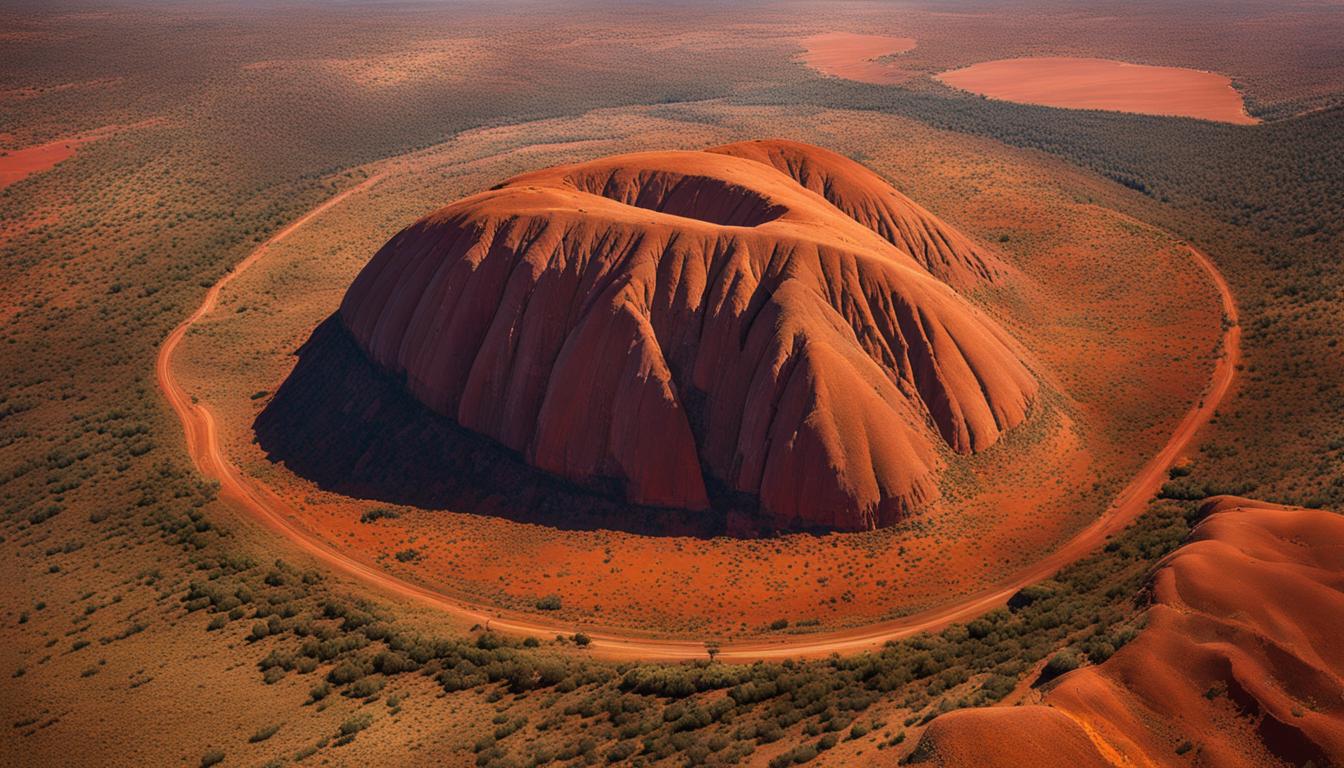
Come along with us as we explore the Aboriginal heritage of Uluru, also known as Ayers Rock. This stunning natural beauty captivates with its visual appeal and carries significant cultural significance for the Aboriginal Australians. We will delve into the indigenous history of Uluru and reveal the sacred sites that are integral to Aboriginal tradition in Australia.
Key Takeaways:
- Uluru, also known as Ayers Rock, is an iconic landmark with deep cultural roots.
- The Anangu people, the traditional owners, have inhabited the Uluru region for over 60,000 years.
- Uluru holds immense sacred significance and is considered one of Australia’s most important spiritual sites.
- The Anangu people’s rich cultural history and their connection to the land are vital elements of their identity.
- Uluru’s Aboriginal heritage is an integral part of the Dreamtime stories and traditions.
The Anangu People and Uluru
The Anangu people are the local tribe in the Uluru region and have lived there for centuries. Their culture, known as Tjukurpa, forms the foundation of their society and beliefs. They have a deep connection to the land and believe that the landscape of Uluru was shaped by the movements of their ancestral beings. This connection to the land and their ancestral heritage is of immense cultural significance to the Anangu people.
Uluru-Kata Tjuta National Park, which encompasses Uluru, serves as a vital link to the past for the Anangu people. It is a place where their traditions, stories, and cultural practices are preserved and celebrated. The park is not only a physical marker of their cultural significance but also a means to pass on their traditions and knowledge to future generations.
Through their cultural practices and storytelling, the Anangu people ensure that the cultural significance of Uluru remains alive and vibrant. They maintain a deep respect for this sacred site and actively participate in its conservation and preservation.
“The cultural significance of Uluru is embedded in every aspect of our lives. It carries the stories of our creation and our ancestral beings. It is a place where we come together to search for knowledge, celebrate our culture, and connect with our identity as Anangu people.” – Anangu elder
Visitors to Uluru have the opportunity to learn about the Anangu culture through guided tours and immersive experiences. Aboriginal tour guides, who are local experts, share their knowledge and stories, deepening the visitors’ understanding of the cultural significance of Uluru and its surroundings.
The Meaning of Tjukurpa
Tjukurpa, meaning “dreaming” or “creation” in the Anangu language, encompasses the spiritual beliefs, stories, and laws of the Anangu people. It guides their way of life, their relationship with the land, and their interactions with each other. Tjukurpa is a living tradition that is passed down orally from generation to generation, ensuring the continuity of their cultural heritage.
The Uluru-Kata Tjuta National Park
The Uluru-Kata Tjuta National Park is not only a place of cultural importance but also a haven for biodiversity. It is home to diverse plant and animal species, many of which are unique to the region. The park is managed jointly by the Anangu people and Parks Australia, with a shared commitment to preserving the natural and cultural values of the area.
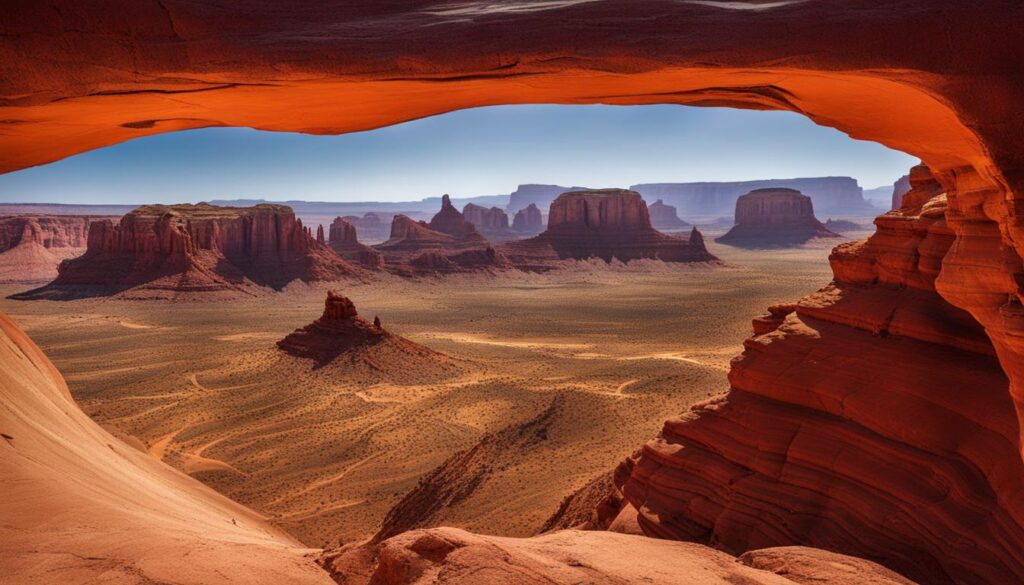
| Uluru’s Significance | Description |
|---|---|
| Cultural Importance | Uluru is a sacred site for the Anangu people, representing their cultural heritage and spiritual beliefs. |
| Traditional Owners | The Anangu people continue to be the traditional owners of Uluru and are responsible for its conservation. |
| Geological Significance | Uluru’s formation over 500 million years provides valuable insights into the Earth’s history and natural processes. |
Cultural Connections at Uluru
When visiting Uluru and Kata Tjuta, you have the incredible opportunity to immerse yourself in the rich cultural connections that exist within the land. At the on-site Cultural Centre, you can delve deeper into the captivating narratives and age-old traditions of the Anangu people, the traditional owners of the land. It is a place where the stories of the past come alive, providing a profound understanding of the significance and essence of Uluru.
The Cultural Centre showcases the profound connection between the Anangu people and Uluru, highlighting the importance of the land in their daily lives, rituals, and customs. Here, you can witness traditional art forms, learn about the Dreaming stories, and gain a deeper appreciation for the sacredness of Uluru.
As you explore the area, guided by knowledgeable Aboriginal tour guides who are local experts, you will gain insights into the cultural significance of Uluru and its surrounding landscape. They share captivating stories and anecdotes that bring the land to life, allowing you to truly grasp the deep-rooted heritage and spiritual importance of Uluru to the Anangu people.
Uluru is not just a physical landmark but an embodiment of the spirit and history of the Anangu people and their ancestors. It is a place where culture and nature intertwine, creating a profound and awe-inspiring experience for all who visit.
Join us on a journey to discover the cultural connections at Uluru:
- Visit the on-site Cultural Centre and explore the captivating exhibitions that celebrate the Anangu people and their rich cultural heritage.
- Participate in cultural tours led by Aboriginal tour guides who will provide deep insights into the significance of Uluru and share extraordinary stories.
- Engage with the ancient art forms, Tjukurpa, and learn about the spiritual connection between the Anangu people and the land.
“Uluru is not just a rock, it’s so much more. It’s our connection to the land, our traditions, and our ancestors. It’s a living testament to our culture and a sacred place that holds immense significance for us.” – Anangu Elder
By immersing yourself in the cultural experiences at Uluru, you will gain a profound appreciation for the depth and richness of the Aboriginal culture, and the significance of Uluru as a spiritual and sacred place.
Anangu Way of Life
The Anangu people hold a deep connection to Uluru, continuing to live in harmony with their ancient traditions and laws. Their way of life revolves around the land, known as Tjukurpa, which encompasses their beliefs, customs, and values. This way of life emphasizes the interdependence between people, animals, and the environment, highlighting the interconnectedness of all living beings.
Through the practice of oral history, the Anangu people pass down their rich cultural heritage from one generation to the next. This ensures the preservation of their ancient customs and traditions that have shaped their society for thousands of years, allowing them to maintain a strong sense of identity and belonging.
Protecting and preserving their cultural heritage is of utmost importance to the Anangu people. They are dedicated to safeguarding the traditions and knowledge that have been passed down through the ages, ensuring the continuity of their cultural legacy and the integrity of their way of life.
Anangu Wisdom
“We have a responsibility to care for the land, to live in harmony with nature, and to honor the wisdom of our ancestors. This is the essence of our way of life.”
– Traditional Owner of Uluru
The Anangu people’s commitment to their cultural heritage extends beyond their own community. They strive to raise awareness and educate visitors about the significance of Uluru and the importance of respecting Aboriginal culture and traditions. Through cultural tours and interactions, visitors have the opportunity to gain a deeper understanding of the Anangu way of life and the profound spiritual connection they share with Uluru.

Geological Features of Uluru
| Feature | Description |
|---|---|
| Monolith | Uluru is a massive rock monolith, standing approximately 348 meters (1,142 feet) tall and measuring around 3.6 kilometers (2.2 miles) in length. |
| Recesses and Caves | The surface of Uluru is adorned with recesses and caves, some of which contain ancient rock paintings and engravings. |
| Vertical Joints | The rock exhibits vertical joints, forming distinct columns that enhance its aesthetic appeal and geological significance. |
| Giant Ripple Marks | Uluru’s sandstone features fascinating giant ripple marks, evidence of ancient underwater currents in the region’s geological past. |
| Kata Tjuta | Kata Tjuta, also known as the Olgas, is a nearby cluster of large domed rock formations, offering further geological interest and research opportunities. |
Uluru’s geological features provide a captivating glimpse into the Earth’s ancient processes and its ever-changing landscapes. It reminds us of the dynamic nature of the planet and the enduring beauty that nature has sculpted over millions of years.
Conservation and Protection
Uluru and its surrounding areas hold significant ecological value, making the conservation and protection of this unique landscape essential. As part of our commitment to preserving the natural beauty and cultural heritage of Uluru, the area is encompassed within the Uluru-Kata Tjuta National Park.
The Uluru-Kata Tjuta National Park serves as a sanctuary for the diverse biodiversity, cultural significance, and social features of the region. By safeguarding this extraordinary environment, we ensure that future generations can continue to experience and appreciate the immense beauty and significance of Uluru.
Every year, millions of visitors come to Uluru, drawn by its remarkable features and cultural importance. As custodians of this sacred site, it is our responsibility to protect its ecological balance and maintain its integrity.
Conservation efforts within the Uluru-Kata Tjuta National Park focus on preserving the natural habitats, native flora, and fauna that thrive in this arid red desert landscape. By maintaining the delicate ecological balance, we provide a sustainable environment for the unique species that call this area home.
“Protecting the environment is crucial for the sustainability of the area, as it is visited by millions of tourists each year. By conserving Uluru and its surrounding areas, we ensure that future generations can continue to experience and appreciate the beauty and significance of this iconic destination.”
Our commitment to conservation goes hand in hand with respecting and preserving the cultural heritage of the Anangu people, the traditional owners of Uluru. By safeguarding their sacred sites, stories, and traditions, we honor their legacy and ensure the preservation of their cultural identity.
Preservation Efforts
Preservation and protection programs within the Uluru-Kata Tjuta National Park encompass various initiatives:
- Education and awareness programs: Promoting responsible visitor behavior and raising awareness about the ecological significance of Uluru.
- Wildlife conservation: Monitoring and managing the native wildlife populations, preserving their natural habitats, and protecting threatened species.
- Fire management: Implementing controlled burns and firebreaks to mitigate the risks of wildfires, which may disrupt the ecological balance.
- Visitor management: Regulating visitor access and implementing sustainable practices to reduce the environmental impact of tourism.
By implementing these preservation efforts, we strive to strike a balance between allowing visitors to experience the magic of Uluru while ensuring its long-term sustainability.
Preserving for the Future
Preserving the natural beauty and cultural significance of Uluru is not only crucial for the present but also for the future. Our efforts today ensure that this iconic landmark remains a symbol of Australia’s rich cultural heritage for generations to come.
Ultimately, it is our collective responsibility to protect and conserve Uluru and its surrounding areas, allowing us and future generations to continue discovering and cherishing the remarkable wonders of this sacred land.
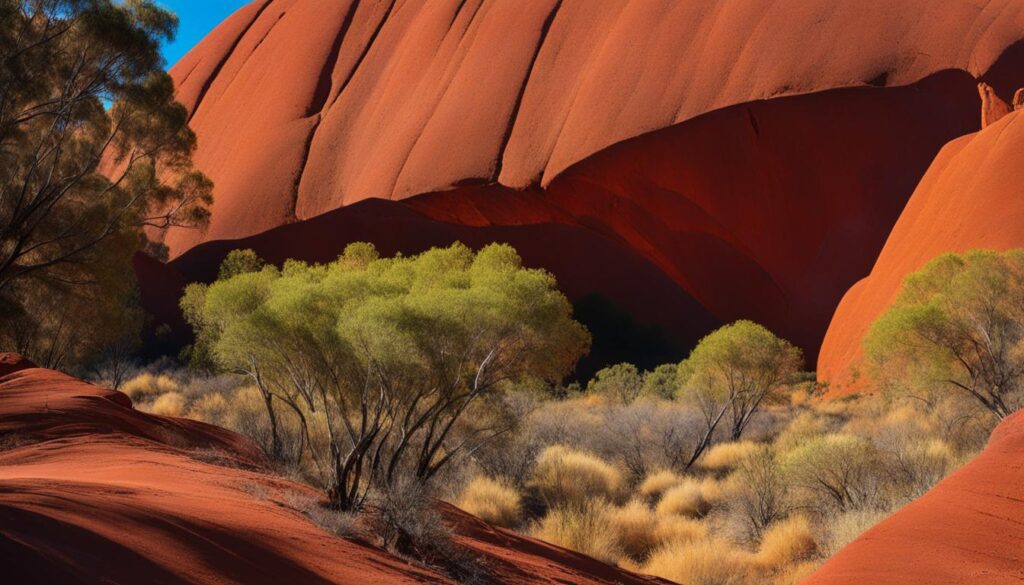
Discovering Anangu Culture at Uluru
Visiting Uluru offers a unique opportunity to immerse ourselves in the rich cultural heritage of the Anangu people. Cultural tours led by Aboriginal guides and traditional owners allow visitors to learn about the history, traditions, and spirituality of the region. Each side of Uluru has its own creation story, and these tours provide insight into the colorful tales that form the foundation of Aboriginal culture in this important part of Australia.
Exploring Anangu Culture through Guided Tours
When we join a cultural tour at Uluru, we have the opportunity to engage with Anangu guides, who share their knowledge and stories with passion and authenticity. These tours offer a deeper understanding of the significance of Uluru to the Anangu people and provide insights into their way of life.
“Uluru is not just a rock – it is our identity, our connection to the land and the spirits of our ancestors. Through these tours, we can share our culture and keep it alive for future generations.”
These guided tours take us on a journey through the sacred sites, teaching us about the Dreamtime stories associated with each area, and the cultural practices that are still observed today. We learn about the traditional hunting and gathering techniques, the significance of rock art, and the spiritual importance of certain plants and animals in Anangu culture.
Preserving Anangu Culture for Generations to Come
The Anangu people are committed to preserving and sharing their cultural heritage, and the guided tours at Uluru play a crucial role in achieving this goal. By participating in these tours, we contribute to the cultural preservation efforts of the Anangu people and support the continued transmission of their traditions and knowledge.
Through our interactions with the Anangu guides, we gain a deeper appreciation for the significance of Uluru as a cultural and spiritual landmark. We understand that it is not only a remarkable geological formation but also a living testament to the enduring connection between the Anangu people and their land.
Uluru’s Role in Dreamtime
According to Aboriginal Dreamtime beliefs, Uluru holds a significant place in the creation story. It is believed that Uluru was created by ancestral beings during the Dreaming, playing a vital role in the formation of the world. The rock’s physical features and rock paintings are seen as evidence of this ancient connection to the Dreamtime. Uluru serves as a powerful symbol of Aboriginal culture and spirituality, representing the essence of their society, traditions, and heritage.
Uluru’s importance in the Dreamtime narrative is deeply rooted in the Aboriginal culture and history. It is viewed as a sacred site where the ancient stories and teachings of the Anangu people originated. The Dreamtime, also known as the Dreaming, is the spiritual foundation of Aboriginal identity, encompassing their beliefs about creation, the land, and their place within the natural world.
“The Dreamtime is the realm of timeless beings who created the world and everything in it. Uluru is believed to be a tangible manifestation of the power and knowledge of these ancestral beings,” emphasized Sarah Wilson, an expert in Aboriginal culture.
The physical presence of Uluru, with its imposing size and unique geological formations, is a testament to its significance in the Dreamtime. The rock formations, caves, and natural features of Uluru are considered as sacred sites and are often adorned with intricate rock art, depicting stories and symbols that convey the spiritual teachings and wisdom of the Anangu people.
Uluru’s Cultural Significance
The cultural significance of Uluru goes beyond its geological formation. It is a place where ceremonies, rituals, and gatherings have taken place for thousands of years. The Anangu people continue to maintain a strong connection to Uluru, actively engaging in cultural practices and sharing their traditions with younger generations.
The Dreamtime stories associated with Uluru provide a moral and ethical framework that guides the Anangu people’s behavior and interactions with the land and each other. These stories teach respect, responsibility, and the importance of maintaining a harmonious relationship with the natural environment.
For the Anangu people, Uluru is not just a physical landmark; it is a living cultural landscape that reflects their spirituality, identity, and holistic worldview. It serves as a source of inspiration, knowledge, and connection to their ancestors, strengthening their sense of belonging and cultural pride.
| Uluru’s Role in Dreamtime | Uluru’s Cultural Significance |
|---|---|
| Believed to be created by ancestral beings during the Dreaming. | Acts as a sacred site for ceremonies and rituals. |
| Physical features and rock art display evidence of the Dreamtime connection. | Cultural practices, traditions, and teachings passed down through generations. |
| Embodies the spirituality and essence of Aboriginal society. | Teaches respect, responsibility, and harmonious relationship with the land. |
The role of Uluru in the Dreamtime narrative and its cultural significance make it a site of immense importance to the Aboriginal people. It continues to be a source of inspiration, knowledge, and pride for the Anangu community, as well as a place for visitors to learn and appreciate the depth and beauty of Aboriginal culture and spirituality.
Conclusion
Uluru, with its deep cultural significance and natural beauty, embodies the Aboriginal roots that connect us to the past. The Anangu people, as the custodians of this sacred land, have safeguarded their rich cultural heritage for generations. Uluru stands as a testament to the spiritual beliefs and ancestral stories of the Aboriginal Dreamtime.
The conservation efforts invested in Uluru and the surrounding Uluru-Kata Tjuta National Park ensure the preservation of this invaluable cultural and natural heritage. This protection allows visitors to experience the profound beauty and depth of Aboriginal culture in Australia. From the majestic rock formation to the sacred sites that hold centuries of indigenous history, Uluru is a window into the world of Aboriginal spirituality and tradition.
As we explore Uluru-Kata Tjuta National Park, we are invited to immerse ourselves in the stories, traditions, and customs that have shaped the Anangu people’s way of life. The park provides an opportunity to connect with the land, learn about the significance of Uluru, and gain a deeper understanding of Australia’s indigenous history. Uluru’s enduring presence serves as a reminder of the shared responsibility we have in protecting and celebrating sacred sites like it around the country.
Yes, Uluru is a deeply significant Aboriginal site. It holds immense cultural and spiritual importance for the Aboriginal people of Australia.
Uluru has profound cultural significance as it is recognized as a sacred site and plays a significant role in the Aboriginal Dreamtime stories. It is considered one of the most important and sacred sites in Australia, representing the essence of Aboriginal culture and spirituality.
The Anangu people are the traditional owners of the land where Uluru is located. They have lived in the Uluru region for over 60,000 years and have a rich cultural history. Uluru’s rock formation is of immense significance. It holds both geological and cultural values. The rock itself is believed to have formed over 500 million years ago and is a remarkable site for geologists. Additionally, it holds sacred significance for the Aboriginal people and is associated with their ancestral beings and creation stories.
The Uluru-Kata Tjuta National Park is a protected area that encompasses Uluru and Kata Tjuta. It holds immense cultural significance to the Anangu people and serves as a connection to their past and a way to pass on their traditions to future generations. The park safeguards the biodiversity, cultural heritage, and social features of the region.
The Anangu people live in accordance with their ancient traditions and laws. Their way of life centers around the land, Tjukurpa (the ancestral law), and the connection between people, animals, and the environment. They strive to protect their cultural heritage and maintain the ancient customs that have shaped their society for thousands of years.
Uluru is estimated to be approximately 500 million years old, according to scientific studies of its rock formation. Its unique composition and size make it an important site for geologists.
Conservation is crucial for Uluru and its surrounding areas to protect the significant cultural and natural heritage. The Uluru-Kata Tjuta National Park ensures the preservation of biodiversity, cultural values, and social features of the region, allowing future generations to experience and appreciate the beauty of Uluru. Visitors to Uluru have the opportunity to learn about Anangu culture through cultural tours led by Aboriginal guides and traditional owners. The on-site Cultural Centre provides a deeper understanding of the narratives and traditions of the Anangu people, allowing visitors to appreciate the rich history and cultural importance of the area.
Uluru holds a significant place in the Aboriginal Dreamtime beliefs. It is believed to have been created by ancestral beings during the Dreaming, playing a vital role in the formation of the world. The rock’s physical features and rock paintings are seen as evidence of this ancient connection to the Dreamtime.
FAQ
Is Uluru an Aboriginal site?
What is the cultural significance of Uluru?
Who are the traditional owners of Uluru?
What is the significance of Uluru’s rock formation?
What is the Uluru-Kata Tjuta National Park?
What is the Anangu way of life?
How old is Uluru?
Why is conservation important for Uluru?
How can I learn about Anangu culture at Uluru?
What is Uluru’s role in Dreamtime?
Mary is a passionate writer who brings creativity and a fresh perspective to our team. Her words have the power to captivate and inspire, making her an essential contributor to our content. Mary’s commitment to storytelling and dedication to promoting Indigenous culture ensures that her work touches the hearts of our readers. We’re fortunate to have her as part of our team.
-

 Culture2 weeks ago
Culture2 weeks agoUnderstanding Aboriginal Totem Significance
-
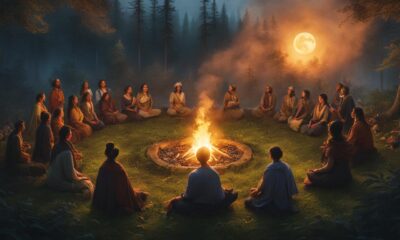
 Torres Strait Islanders6 hours ago
Torres Strait Islanders6 hours agoSacred Healing: Discovering Indigenous Health Secrets
-
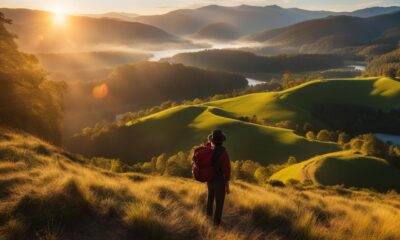
 Torres Strait Islanders7 hours ago
Torres Strait Islanders7 hours agoJourney to Wellness: Indigenous Health Product Guide
-
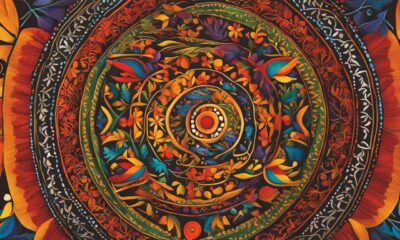
 Torres Strait Islanders7 hours ago
Torres Strait Islanders7 hours agoCultural Vitality: Indigenous Health Tips
-
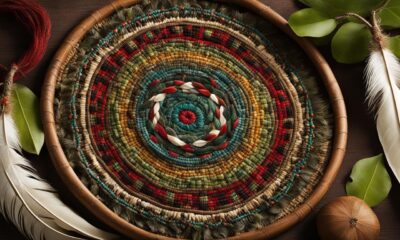
 Torres Strait Islanders6 hours ago
Torres Strait Islanders6 hours agoEmbrace Indigenous Wisdom: Top Well-Being Products
-

 Torres Strait Islanders6 hours ago
Torres Strait Islanders6 hours agoHolistic Health: Indigenous Wellness Explored
-

 Torres Strait Islanders7 hours ago
Torres Strait Islanders7 hours agoNature’s Wisdom: Indigenous Well-Being Remedies
-

 Torres Strait Islanders6 hours ago
Torres Strait Islanders6 hours agoIndigenous Health Products Guide for Wellness












